Interdependence of buyer and supplier firms in supply chain development
VerifiedAdded on 2021/06/02
|24
|7961
|156
AI Summary
It is one of the foremost practices of SCM that has become very significant aspect for the firms, it is the key tools that are used by organization’s to survive in the competitive market to enhance the profitability as well as the firms performance (Choon et al., 2002). The modern evaluation of SCM practices that embraces of alliances, with the supplier, outsourcing process, compression cycle time, sharing of technology and information by expending the acquiring the superiority and the relation with buyer and supplier activities
Contribute Materials
Your contribution can guide someone’s learning journey. Share your
documents today.
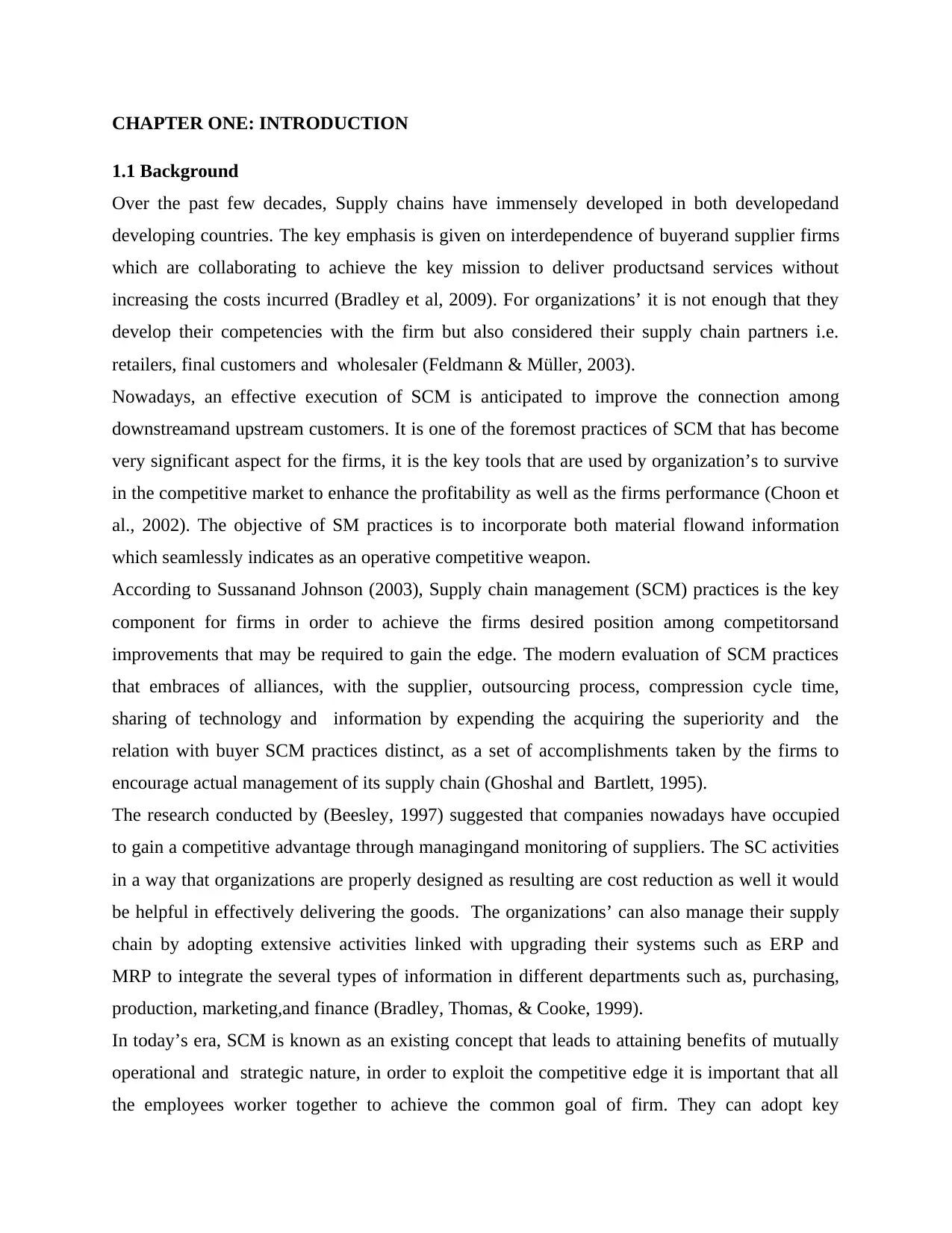
CHAPTER ONE: INTRODUCTION
1.1 Background
Over the past few decades, Supply chains have immensely developed in both developedand
developing countries. The key emphasis is given on interdependence of buyerand supplier firms
which are collaborating to achieve the key mission to deliver productsand services without
increasing the costs incurred (Bradley et al, 2009). For organizations’ it is not enough that they
develop their competencies with the firm but also considered their supply chain partners i.e.
retailers, final customers and wholesaler (Feldmann & Müller, 2003).
Nowadays, an effective execution of SCM is anticipated to improve the connection among
downstreamand upstream customers. It is one of the foremost practices of SCM that has become
very significant aspect for the firms, it is the key tools that are used by organization’s to survive
in the competitive market to enhance the profitability as well as the firms performance (Choon et
al., 2002). The objective of SM practices is to incorporate both material flowand information
which seamlessly indicates as an operative competitive weapon.
According to Sussanand Johnson (2003), Supply chain management (SCM) practices is the key
component for firms in order to achieve the firms desired position among competitorsand
improvements that may be required to gain the edge. The modern evaluation of SCM practices
that embraces of alliances, with the supplier, outsourcing process, compression cycle time,
sharing of technology and information by expending the acquiring the superiority and the
relation with buyer SCM practices distinct, as a set of accomplishments taken by the firms to
encourage actual management of its supply chain (Ghoshal and Bartlett, 1995).
The research conducted by (Beesley, 1997) suggested that companies nowadays have occupied
to gain a competitive advantage through managingand monitoring of suppliers. The SC activities
in a way that organizations are properly designed as resulting are cost reduction as well it would
be helpful in effectively delivering the goods. The organizations’ can also manage their supply
chain by adopting extensive activities linked with upgrading their systems such as ERP and
MRP to integrate the several types of information in different departments such as, purchasing,
production, marketing,and finance (Bradley, Thomas, & Cooke, 1999).
In today’s era, SCM is known as an existing concept that leads to attaining benefits of mutually
operational and strategic nature, in order to exploit the competitive edge it is important that all
the employees worker together to achieve the common goal of firm. They can adopt key
1.1 Background
Over the past few decades, Supply chains have immensely developed in both developedand
developing countries. The key emphasis is given on interdependence of buyerand supplier firms
which are collaborating to achieve the key mission to deliver productsand services without
increasing the costs incurred (Bradley et al, 2009). For organizations’ it is not enough that they
develop their competencies with the firm but also considered their supply chain partners i.e.
retailers, final customers and wholesaler (Feldmann & Müller, 2003).
Nowadays, an effective execution of SCM is anticipated to improve the connection among
downstreamand upstream customers. It is one of the foremost practices of SCM that has become
very significant aspect for the firms, it is the key tools that are used by organization’s to survive
in the competitive market to enhance the profitability as well as the firms performance (Choon et
al., 2002). The objective of SM practices is to incorporate both material flowand information
which seamlessly indicates as an operative competitive weapon.
According to Sussanand Johnson (2003), Supply chain management (SCM) practices is the key
component for firms in order to achieve the firms desired position among competitorsand
improvements that may be required to gain the edge. The modern evaluation of SCM practices
that embraces of alliances, with the supplier, outsourcing process, compression cycle time,
sharing of technology and information by expending the acquiring the superiority and the
relation with buyer SCM practices distinct, as a set of accomplishments taken by the firms to
encourage actual management of its supply chain (Ghoshal and Bartlett, 1995).
The research conducted by (Beesley, 1997) suggested that companies nowadays have occupied
to gain a competitive advantage through managingand monitoring of suppliers. The SC activities
in a way that organizations are properly designed as resulting are cost reduction as well it would
be helpful in effectively delivering the goods. The organizations’ can also manage their supply
chain by adopting extensive activities linked with upgrading their systems such as ERP and
MRP to integrate the several types of information in different departments such as, purchasing,
production, marketing,and finance (Bradley, Thomas, & Cooke, 1999).
In today’s era, SCM is known as an existing concept that leads to attaining benefits of mutually
operational and strategic nature, in order to exploit the competitive edge it is important that all
the employees worker together to achieve the common goal of firm. They can adopt key
Secure Best Marks with AI Grader
Need help grading? Try our AI Grader for instant feedback on your assignments.
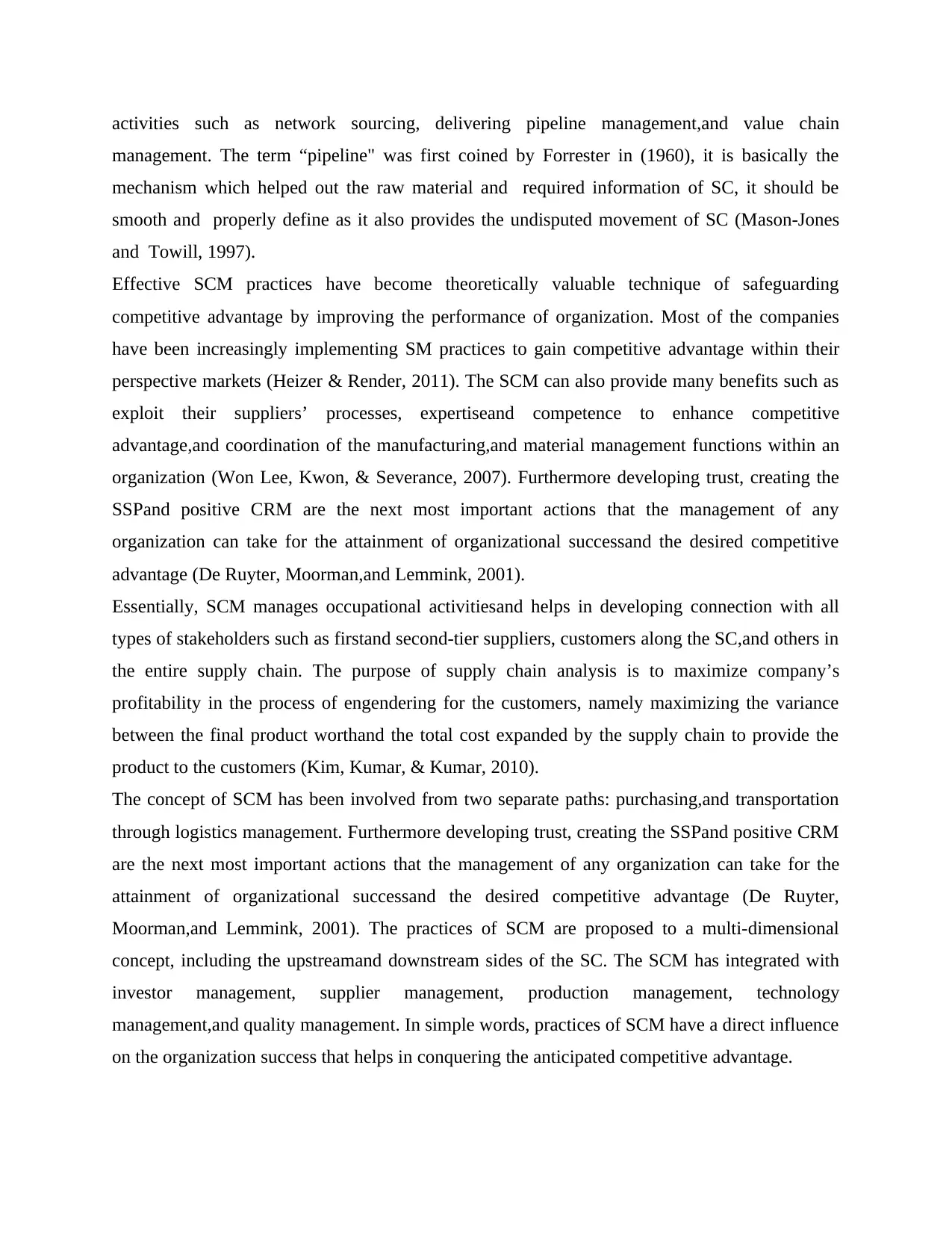
activities such as network sourcing, delivering pipeline management,and value chain
management. The term “pipeline" was first coined by Forrester in (1960), it is basically the
mechanism which helped out the raw material and required information of SC, it should be
smooth and properly define as it also provides the undisputed movement of SC (Mason‐Jones
and Towill, 1997).
Effective SCM practices have become theoretically valuable technique of safeguarding
competitive advantage by improving the performance of organization. Most of the companies
have been increasingly implementing SM practices to gain competitive advantage within their
perspective markets (Heizer & Render, 2011). The SCM can also provide many benefits such as
exploit their suppliers’ processes, expertiseand competence to enhance competitive
advantage,and coordination of the manufacturing,and material management functions within an
organization (Won Lee, Kwon, & Severance, 2007). Furthermore developing trust, creating the
SSPand positive CRM are the next most important actions that the management of any
organization can take for the attainment of organizational successand the desired competitive
advantage (De Ruyter, Moorman,and Lemmink, 2001).
Essentially, SCM manages occupational activitiesand helps in developing connection with all
types of stakeholders such as firstand second-tier suppliers, customers along the SC,and others in
the entire supply chain. The purpose of supply chain analysis is to maximize company’s
profitability in the process of engendering for the customers, namely maximizing the variance
between the final product worthand the total cost expanded by the supply chain to provide the
product to the customers (Kim, Kumar, & Kumar, 2010).
The concept of SCM has been involved from two separate paths: purchasing,and transportation
through logistics management. Furthermore developing trust, creating the SSPand positive CRM
are the next most important actions that the management of any organization can take for the
attainment of organizational successand the desired competitive advantage (De Ruyter,
Moorman,and Lemmink, 2001). The practices of SCM are proposed to a multi-dimensional
concept, including the upstreamand downstream sides of the SC. The SCM has integrated with
investor management, supplier management, production management, technology
management,and quality management. In simple words, practices of SCM have a direct influence
on the organization success that helps in conquering the anticipated competitive advantage.
management. The term “pipeline" was first coined by Forrester in (1960), it is basically the
mechanism which helped out the raw material and required information of SC, it should be
smooth and properly define as it also provides the undisputed movement of SC (Mason‐Jones
and Towill, 1997).
Effective SCM practices have become theoretically valuable technique of safeguarding
competitive advantage by improving the performance of organization. Most of the companies
have been increasingly implementing SM practices to gain competitive advantage within their
perspective markets (Heizer & Render, 2011). The SCM can also provide many benefits such as
exploit their suppliers’ processes, expertiseand competence to enhance competitive
advantage,and coordination of the manufacturing,and material management functions within an
organization (Won Lee, Kwon, & Severance, 2007). Furthermore developing trust, creating the
SSPand positive CRM are the next most important actions that the management of any
organization can take for the attainment of organizational successand the desired competitive
advantage (De Ruyter, Moorman,and Lemmink, 2001).
Essentially, SCM manages occupational activitiesand helps in developing connection with all
types of stakeholders such as firstand second-tier suppliers, customers along the SC,and others in
the entire supply chain. The purpose of supply chain analysis is to maximize company’s
profitability in the process of engendering for the customers, namely maximizing the variance
between the final product worthand the total cost expanded by the supply chain to provide the
product to the customers (Kim, Kumar, & Kumar, 2010).
The concept of SCM has been involved from two separate paths: purchasing,and transportation
through logistics management. Furthermore developing trust, creating the SSPand positive CRM
are the next most important actions that the management of any organization can take for the
attainment of organizational successand the desired competitive advantage (De Ruyter,
Moorman,and Lemmink, 2001). The practices of SCM are proposed to a multi-dimensional
concept, including the upstreamand downstream sides of the SC. The SCM has integrated with
investor management, supplier management, production management, technology
management,and quality management. In simple words, practices of SCM have a direct influence
on the organization success that helps in conquering the anticipated competitive advantage.
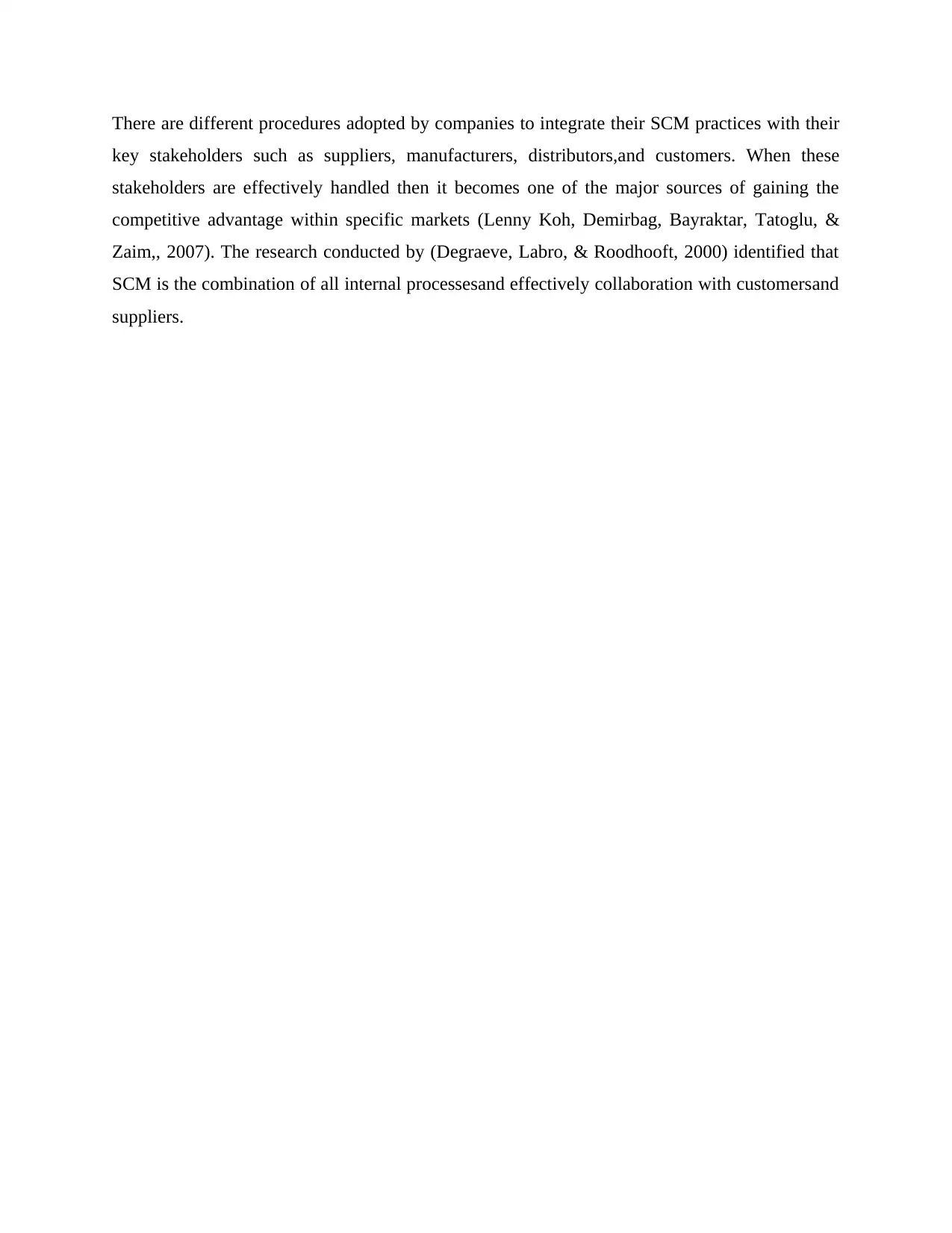
There are different procedures adopted by companies to integrate their SCM practices with their
key stakeholders such as suppliers, manufacturers, distributors,and customers. When these
stakeholders are effectively handled then it becomes one of the major sources of gaining the
competitive advantage within specific markets (Lenny Koh, Demirbag, Bayraktar, Tatoglu, &
Zaim,, 2007). The research conducted by (Degraeve, Labro, & Roodhooft, 2000) identified that
SCM is the combination of all internal processesand effectively collaboration with customersand
suppliers.
key stakeholders such as suppliers, manufacturers, distributors,and customers. When these
stakeholders are effectively handled then it becomes one of the major sources of gaining the
competitive advantage within specific markets (Lenny Koh, Demirbag, Bayraktar, Tatoglu, &
Zaim,, 2007). The research conducted by (Degraeve, Labro, & Roodhooft, 2000) identified that
SCM is the combination of all internal processesand effectively collaboration with customersand
suppliers.
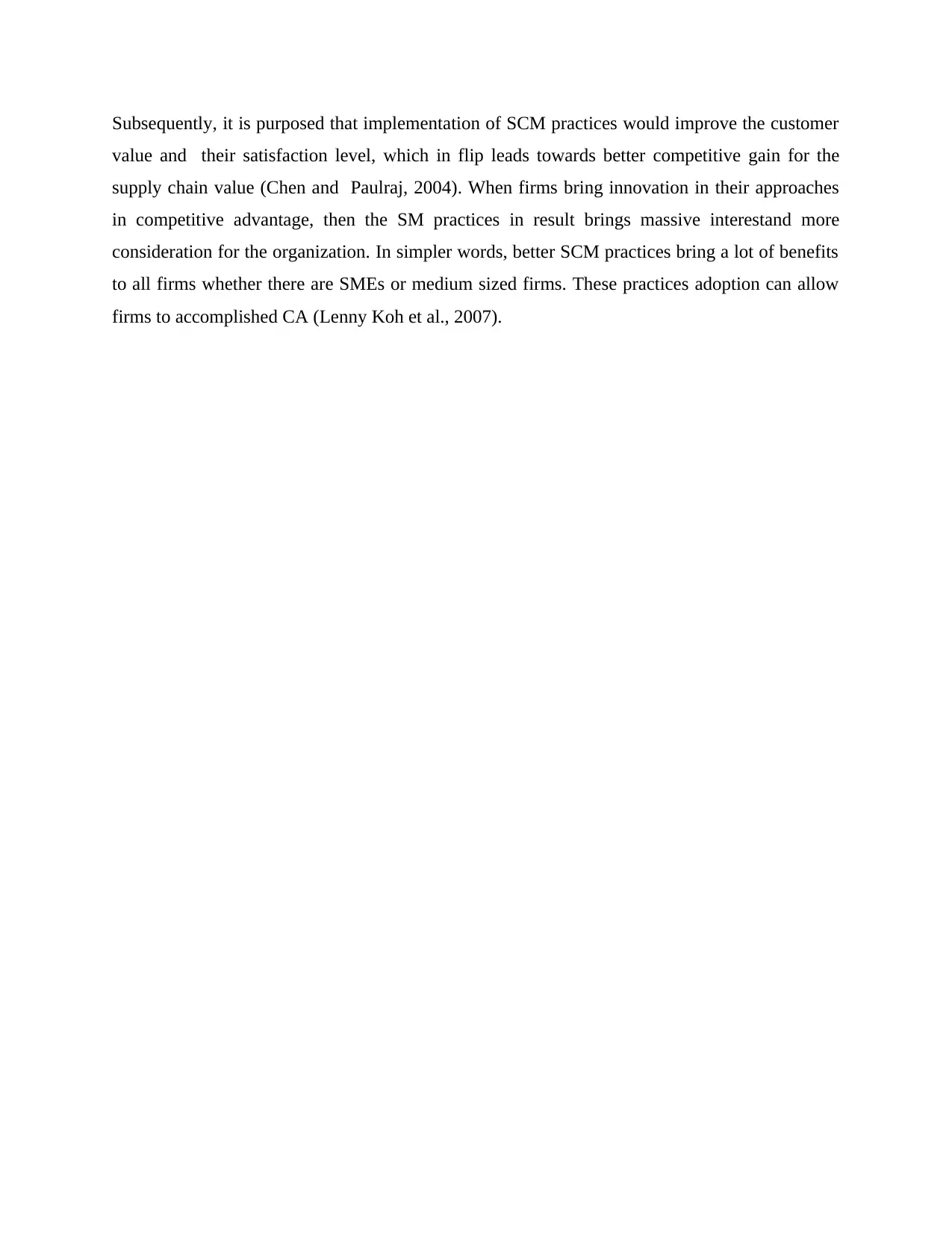
Subsequently, it is purposed that implementation of SCM practices would improve the customer
value and their satisfaction level, which in flip leads towards better competitive gain for the
supply chain value (Chen and Paulraj, 2004). When firms bring innovation in their approaches
in competitive advantage, then the SM practices in result brings massive interestand more
consideration for the organization. In simpler words, better SCM practices bring a lot of benefits
to all firms whether there are SMEs or medium sized firms. These practices adoption can allow
firms to accomplished CA (Lenny Koh et al., 2007).
value and their satisfaction level, which in flip leads towards better competitive gain for the
supply chain value (Chen and Paulraj, 2004). When firms bring innovation in their approaches
in competitive advantage, then the SM practices in result brings massive interestand more
consideration for the organization. In simpler words, better SCM practices bring a lot of benefits
to all firms whether there are SMEs or medium sized firms. These practices adoption can allow
firms to accomplished CA (Lenny Koh et al., 2007).
Secure Best Marks with AI Grader
Need help grading? Try our AI Grader for instant feedback on your assignments.
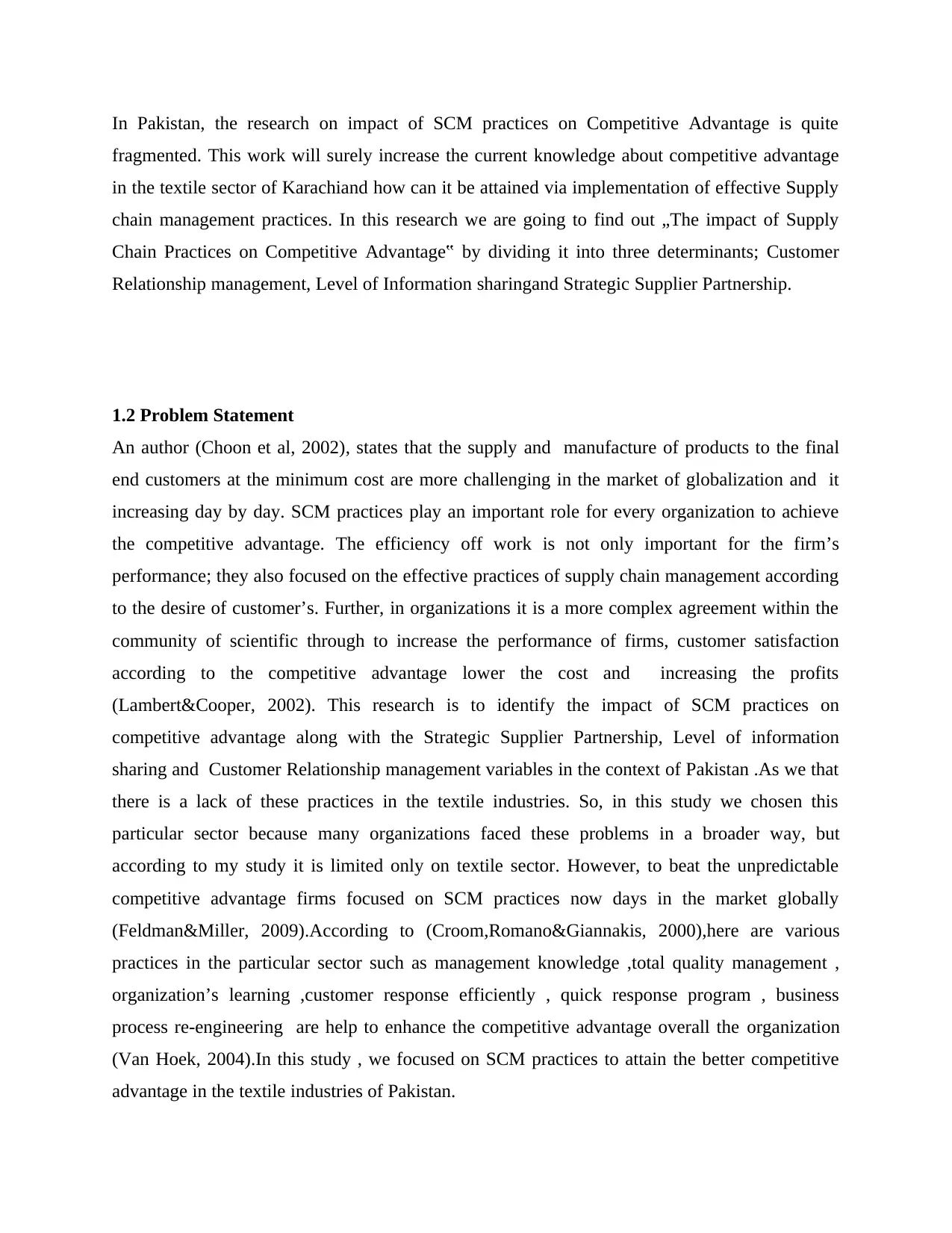
In Pakistan, the research on impact of SCM practices on Competitive Advantage is quite
fragmented. This work will surely increase the current knowledge about competitive advantage
in the textile sector of Karachiand how can it be attained via implementation of effective Supply
chain management practices. In this research we are going to find out „The impact of Supply
Chain Practices on Competitive Advantage‟ by dividing it into three determinants; Customer
Relationship management, Level of Information sharingand Strategic Supplier Partnership.
1.2 Problem Statement
An author (Choon et al, 2002), states that the supply and manufacture of products to the final
end customers at the minimum cost are more challenging in the market of globalization and it
increasing day by day. SCM practices play an important role for every organization to achieve
the competitive advantage. The efficiency off work is not only important for the firm’s
performance; they also focused on the effective practices of supply chain management according
to the desire of customer’s. Further, in organizations it is a more complex agreement within the
community of scientific through to increase the performance of firms, customer satisfaction
according to the competitive advantage lower the cost and increasing the profits
(Lambert&Cooper, 2002). This research is to identify the impact of SCM practices on
competitive advantage along with the Strategic Supplier Partnership, Level of information
sharing and Customer Relationship management variables in the context of Pakistan .As we that
there is a lack of these practices in the textile industries. So, in this study we chosen this
particular sector because many organizations faced these problems in a broader way, but
according to my study it is limited only on textile sector. However, to beat the unpredictable
competitive advantage firms focused on SCM practices now days in the market globally
(Feldman&Miller, 2009).According to (Croom,Romano&Giannakis, 2000),here are various
practices in the particular sector such as management knowledge ,total quality management ,
organization’s learning ,customer response efficiently , quick response program , business
process re-engineering are help to enhance the competitive advantage overall the organization
(Van Hoek, 2004).In this study , we focused on SCM practices to attain the better competitive
advantage in the textile industries of Pakistan.
fragmented. This work will surely increase the current knowledge about competitive advantage
in the textile sector of Karachiand how can it be attained via implementation of effective Supply
chain management practices. In this research we are going to find out „The impact of Supply
Chain Practices on Competitive Advantage‟ by dividing it into three determinants; Customer
Relationship management, Level of Information sharingand Strategic Supplier Partnership.
1.2 Problem Statement
An author (Choon et al, 2002), states that the supply and manufacture of products to the final
end customers at the minimum cost are more challenging in the market of globalization and it
increasing day by day. SCM practices play an important role for every organization to achieve
the competitive advantage. The efficiency off work is not only important for the firm’s
performance; they also focused on the effective practices of supply chain management according
to the desire of customer’s. Further, in organizations it is a more complex agreement within the
community of scientific through to increase the performance of firms, customer satisfaction
according to the competitive advantage lower the cost and increasing the profits
(Lambert&Cooper, 2002). This research is to identify the impact of SCM practices on
competitive advantage along with the Strategic Supplier Partnership, Level of information
sharing and Customer Relationship management variables in the context of Pakistan .As we that
there is a lack of these practices in the textile industries. So, in this study we chosen this
particular sector because many organizations faced these problems in a broader way, but
according to my study it is limited only on textile sector. However, to beat the unpredictable
competitive advantage firms focused on SCM practices now days in the market globally
(Feldman&Miller, 2009).According to (Croom,Romano&Giannakis, 2000),here are various
practices in the particular sector such as management knowledge ,total quality management ,
organization’s learning ,customer response efficiently , quick response program , business
process re-engineering are help to enhance the competitive advantage overall the organization
(Van Hoek, 2004).In this study , we focused on SCM practices to attain the better competitive
advantage in the textile industries of Pakistan.
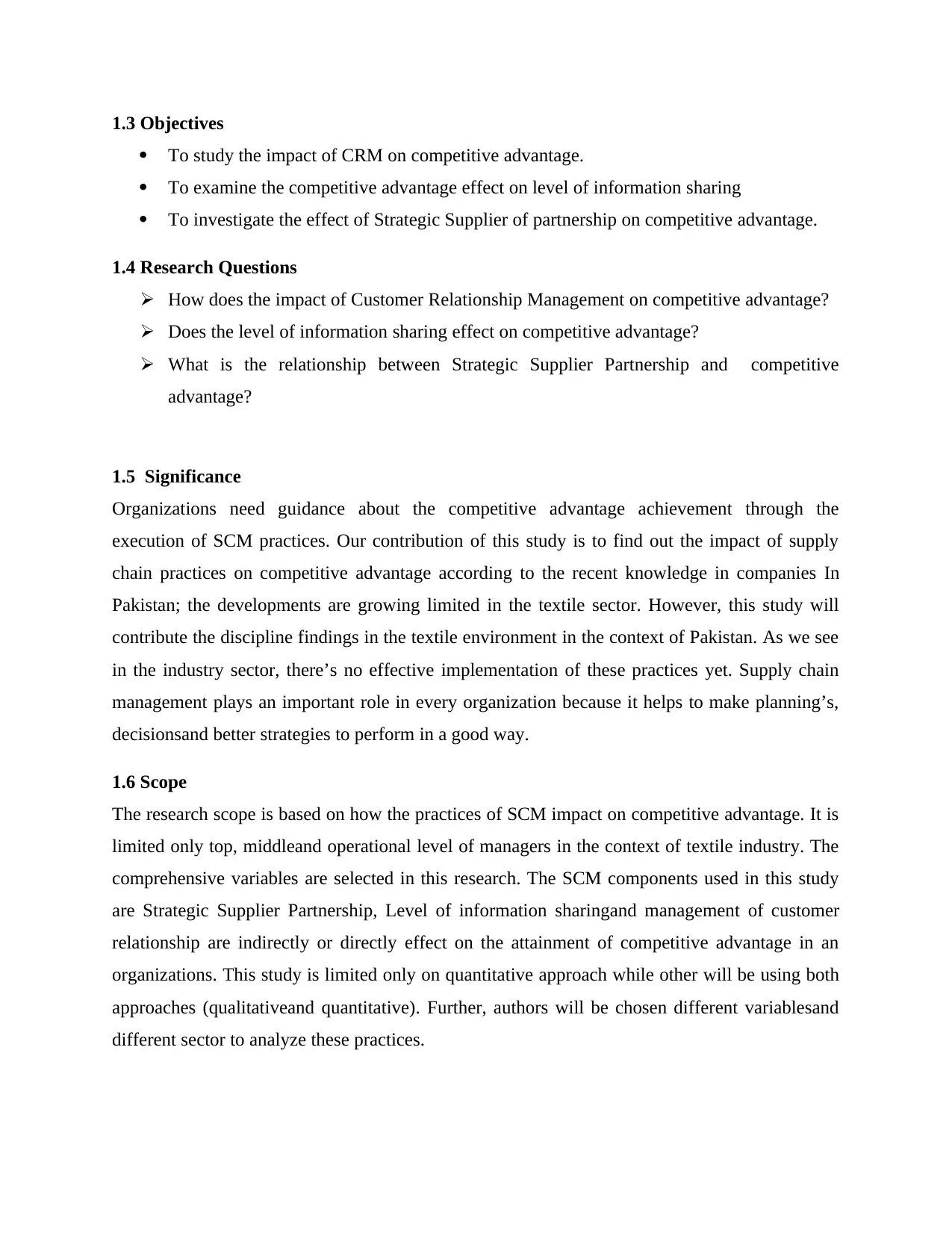
1.3 Objectives
To study the impact of CRM on competitive advantage.
To examine the competitive advantage effect on level of information sharing
To investigate the effect of Strategic Supplier of partnership on competitive advantage.
1.4 Research Questions
How does the impact of Customer Relationship Management on competitive advantage?
Does the level of information sharing effect on competitive advantage?
What is the relationship between Strategic Supplier Partnership and competitive
advantage?
1.5 Significance
Organizations need guidance about the competitive advantage achievement through the
execution of SCM practices. Our contribution of this study is to find out the impact of supply
chain practices on competitive advantage according to the recent knowledge in companies In
Pakistan; the developments are growing limited in the textile sector. However, this study will
contribute the discipline findings in the textile environment in the context of Pakistan. As we see
in the industry sector, there’s no effective implementation of these practices yet. Supply chain
management plays an important role in every organization because it helps to make planning’s,
decisionsand better strategies to perform in a good way.
1.6 Scope
The research scope is based on how the practices of SCM impact on competitive advantage. It is
limited only top, middleand operational level of managers in the context of textile industry. The
comprehensive variables are selected in this research. The SCM components used in this study
are Strategic Supplier Partnership, Level of information sharingand management of customer
relationship are indirectly or directly effect on the attainment of competitive advantage in an
organizations. This study is limited only on quantitative approach while other will be using both
approaches (qualitativeand quantitative). Further, authors will be chosen different variablesand
different sector to analyze these practices.
To study the impact of CRM on competitive advantage.
To examine the competitive advantage effect on level of information sharing
To investigate the effect of Strategic Supplier of partnership on competitive advantage.
1.4 Research Questions
How does the impact of Customer Relationship Management on competitive advantage?
Does the level of information sharing effect on competitive advantage?
What is the relationship between Strategic Supplier Partnership and competitive
advantage?
1.5 Significance
Organizations need guidance about the competitive advantage achievement through the
execution of SCM practices. Our contribution of this study is to find out the impact of supply
chain practices on competitive advantage according to the recent knowledge in companies In
Pakistan; the developments are growing limited in the textile sector. However, this study will
contribute the discipline findings in the textile environment in the context of Pakistan. As we see
in the industry sector, there’s no effective implementation of these practices yet. Supply chain
management plays an important role in every organization because it helps to make planning’s,
decisionsand better strategies to perform in a good way.
1.6 Scope
The research scope is based on how the practices of SCM impact on competitive advantage. It is
limited only top, middleand operational level of managers in the context of textile industry. The
comprehensive variables are selected in this research. The SCM components used in this study
are Strategic Supplier Partnership, Level of information sharingand management of customer
relationship are indirectly or directly effect on the attainment of competitive advantage in an
organizations. This study is limited only on quantitative approach while other will be using both
approaches (qualitativeand quantitative). Further, authors will be chosen different variablesand
different sector to analyze these practices.
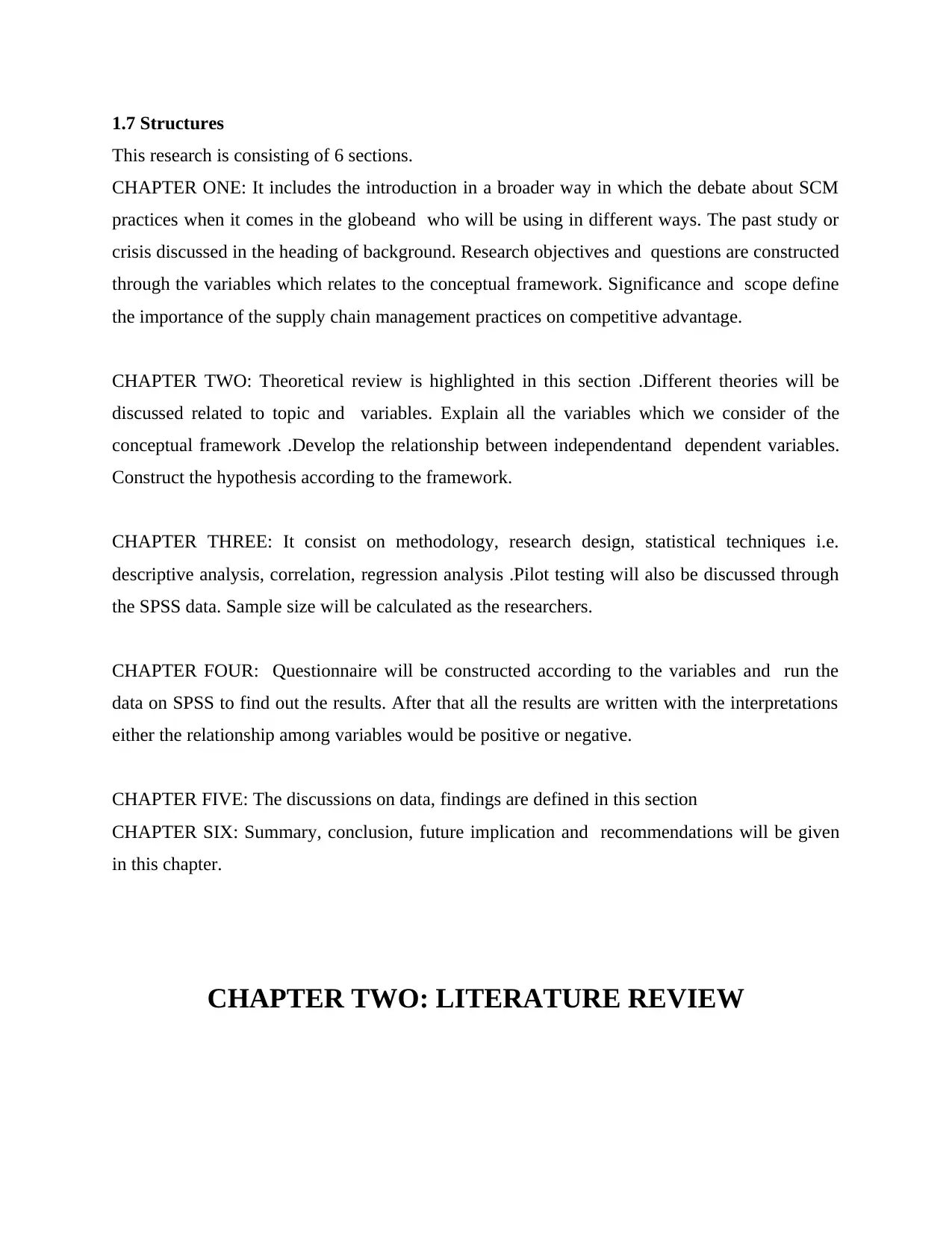
1.7 Structures
This research is consisting of 6 sections.
CHAPTER ONE: It includes the introduction in a broader way in which the debate about SCM
practices when it comes in the globeand who will be using in different ways. The past study or
crisis discussed in the heading of background. Research objectives and questions are constructed
through the variables which relates to the conceptual framework. Significance and scope define
the importance of the supply chain management practices on competitive advantage.
CHAPTER TWO: Theoretical review is highlighted in this section .Different theories will be
discussed related to topic and variables. Explain all the variables which we consider of the
conceptual framework .Develop the relationship between independentand dependent variables.
Construct the hypothesis according to the framework.
CHAPTER THREE: It consist on methodology, research design, statistical techniques i.e.
descriptive analysis, correlation, regression analysis .Pilot testing will also be discussed through
the SPSS data. Sample size will be calculated as the researchers.
CHAPTER FOUR: Questionnaire will be constructed according to the variables and run the
data on SPSS to find out the results. After that all the results are written with the interpretations
either the relationship among variables would be positive or negative.
CHAPTER FIVE: The discussions on data, findings are defined in this section
CHAPTER SIX: Summary, conclusion, future implication and recommendations will be given
in this chapter.
CHAPTER TWO: LITERATURE REVIEW
This research is consisting of 6 sections.
CHAPTER ONE: It includes the introduction in a broader way in which the debate about SCM
practices when it comes in the globeand who will be using in different ways. The past study or
crisis discussed in the heading of background. Research objectives and questions are constructed
through the variables which relates to the conceptual framework. Significance and scope define
the importance of the supply chain management practices on competitive advantage.
CHAPTER TWO: Theoretical review is highlighted in this section .Different theories will be
discussed related to topic and variables. Explain all the variables which we consider of the
conceptual framework .Develop the relationship between independentand dependent variables.
Construct the hypothesis according to the framework.
CHAPTER THREE: It consist on methodology, research design, statistical techniques i.e.
descriptive analysis, correlation, regression analysis .Pilot testing will also be discussed through
the SPSS data. Sample size will be calculated as the researchers.
CHAPTER FOUR: Questionnaire will be constructed according to the variables and run the
data on SPSS to find out the results. After that all the results are written with the interpretations
either the relationship among variables would be positive or negative.
CHAPTER FIVE: The discussions on data, findings are defined in this section
CHAPTER SIX: Summary, conclusion, future implication and recommendations will be given
in this chapter.
CHAPTER TWO: LITERATURE REVIEW
Paraphrase This Document
Need a fresh take? Get an instant paraphrase of this document with our AI Paraphraser
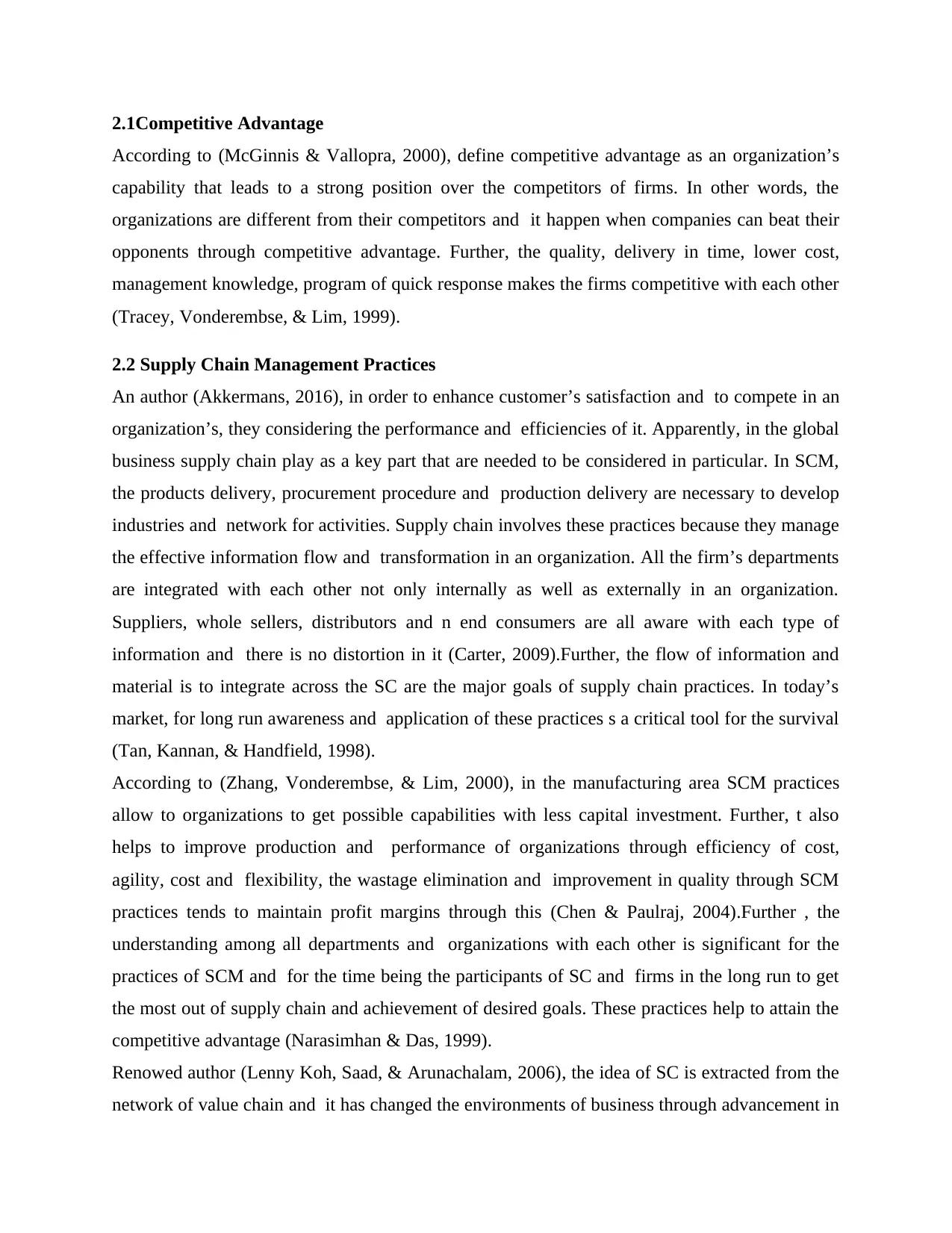
2.1Competitive Advantage
According to (McGinnis & Vallopra, 2000), define competitive advantage as an organization’s
capability that leads to a strong position over the competitors of firms. In other words, the
organizations are different from their competitors and it happen when companies can beat their
opponents through competitive advantage. Further, the quality, delivery in time, lower cost,
management knowledge, program of quick response makes the firms competitive with each other
(Tracey, Vonderembse, & Lim, 1999).
2.2 Supply Chain Management Practices
An author (Akkermans, 2016), in order to enhance customer’s satisfaction and to compete in an
organization’s, they considering the performance and efficiencies of it. Apparently, in the global
business supply chain play as a key part that are needed to be considered in particular. In SCM,
the products delivery, procurement procedure and production delivery are necessary to develop
industries and network for activities. Supply chain involves these practices because they manage
the effective information flow and transformation in an organization. All the firm’s departments
are integrated with each other not only internally as well as externally in an organization.
Suppliers, whole sellers, distributors and n end consumers are all aware with each type of
information and there is no distortion in it (Carter, 2009).Further, the flow of information and
material is to integrate across the SC are the major goals of supply chain practices. In today’s
market, for long run awareness and application of these practices s a critical tool for the survival
(Tan, Kannan, & Handfield, 1998).
According to (Zhang, Vonderembse, & Lim, 2000), in the manufacturing area SCM practices
allow to organizations to get possible capabilities with less capital investment. Further, t also
helps to improve production and performance of organizations through efficiency of cost,
agility, cost and flexibility, the wastage elimination and improvement in quality through SCM
practices tends to maintain profit margins through this (Chen & Paulraj, 2004).Further , the
understanding among all departments and organizations with each other is significant for the
practices of SCM and for the time being the participants of SC and firms in the long run to get
the most out of supply chain and achievement of desired goals. These practices help to attain the
competitive advantage (Narasimhan & Das, 1999).
Renowed author (Lenny Koh, Saad, & Arunachalam, 2006), the idea of SC is extracted from the
network of value chain and it has changed the environments of business through advancement in
According to (McGinnis & Vallopra, 2000), define competitive advantage as an organization’s
capability that leads to a strong position over the competitors of firms. In other words, the
organizations are different from their competitors and it happen when companies can beat their
opponents through competitive advantage. Further, the quality, delivery in time, lower cost,
management knowledge, program of quick response makes the firms competitive with each other
(Tracey, Vonderembse, & Lim, 1999).
2.2 Supply Chain Management Practices
An author (Akkermans, 2016), in order to enhance customer’s satisfaction and to compete in an
organization’s, they considering the performance and efficiencies of it. Apparently, in the global
business supply chain play as a key part that are needed to be considered in particular. In SCM,
the products delivery, procurement procedure and production delivery are necessary to develop
industries and network for activities. Supply chain involves these practices because they manage
the effective information flow and transformation in an organization. All the firm’s departments
are integrated with each other not only internally as well as externally in an organization.
Suppliers, whole sellers, distributors and n end consumers are all aware with each type of
information and there is no distortion in it (Carter, 2009).Further, the flow of information and
material is to integrate across the SC are the major goals of supply chain practices. In today’s
market, for long run awareness and application of these practices s a critical tool for the survival
(Tan, Kannan, & Handfield, 1998).
According to (Zhang, Vonderembse, & Lim, 2000), in the manufacturing area SCM practices
allow to organizations to get possible capabilities with less capital investment. Further, t also
helps to improve production and performance of organizations through efficiency of cost,
agility, cost and flexibility, the wastage elimination and improvement in quality through SCM
practices tends to maintain profit margins through this (Chen & Paulraj, 2004).Further , the
understanding among all departments and organizations with each other is significant for the
practices of SCM and for the time being the participants of SC and firms in the long run to get
the most out of supply chain and achievement of desired goals. These practices help to attain the
competitive advantage (Narasimhan & Das, 1999).
Renowed author (Lenny Koh, Saad, & Arunachalam, 2006), the idea of SC is extracted from the
network of value chain and it has changed the environments of business through advancement in
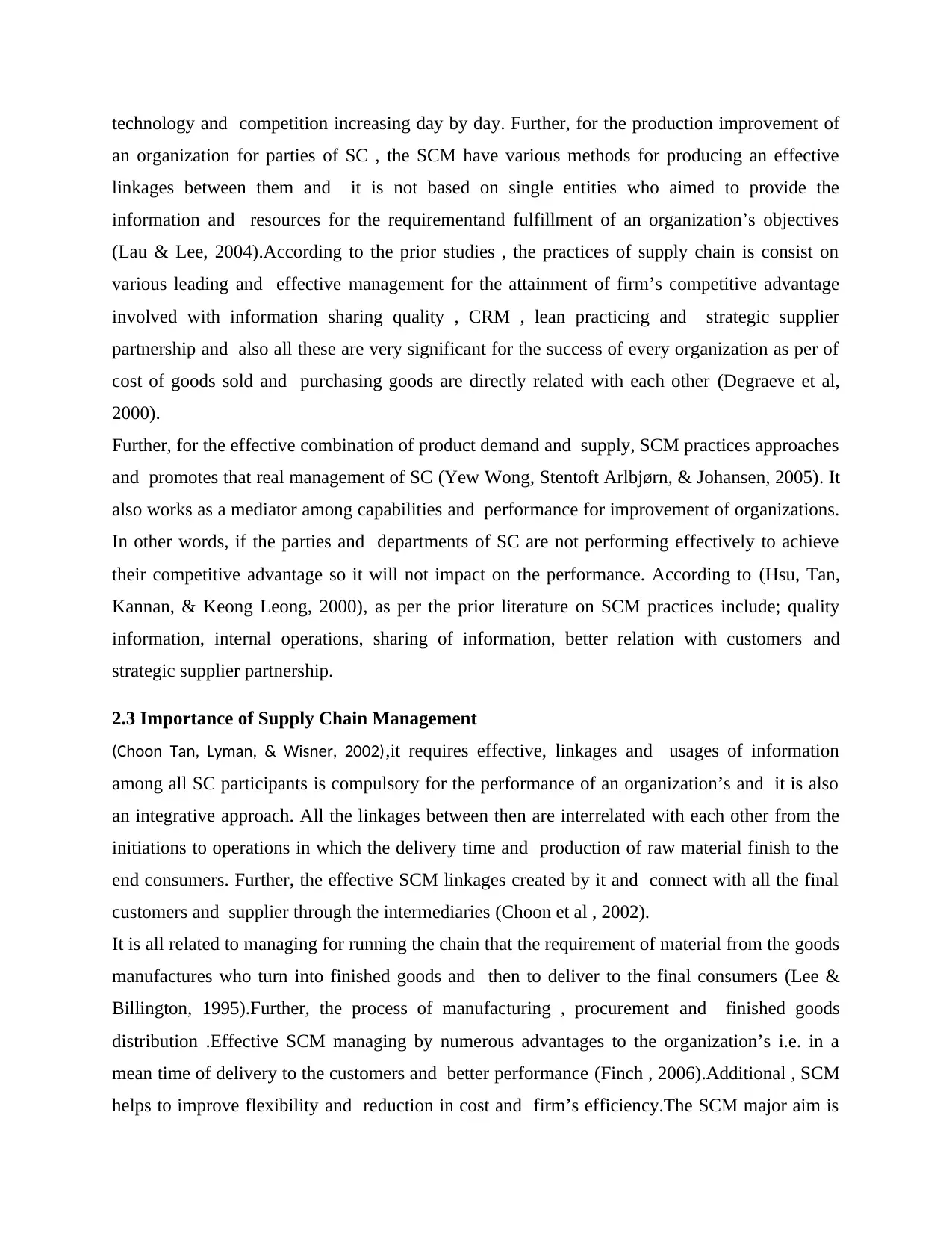
technology and competition increasing day by day. Further, for the production improvement of
an organization for parties of SC , the SCM have various methods for producing an effective
linkages between them and it is not based on single entities who aimed to provide the
information and resources for the requirementand fulfillment of an organization’s objectives
(Lau & Lee, 2004).According to the prior studies , the practices of supply chain is consist on
various leading and effective management for the attainment of firm’s competitive advantage
involved with information sharing quality , CRM , lean practicing and strategic supplier
partnership and also all these are very significant for the success of every organization as per of
cost of goods sold and purchasing goods are directly related with each other (Degraeve et al,
2000).
Further, for the effective combination of product demand and supply, SCM practices approaches
and promotes that real management of SC (Yew Wong, Stentoft Arlbjørn, & Johansen, 2005). It
also works as a mediator among capabilities and performance for improvement of organizations.
In other words, if the parties and departments of SC are not performing effectively to achieve
their competitive advantage so it will not impact on the performance. According to (Hsu, Tan,
Kannan, & Keong Leong, 2000), as per the prior literature on SCM practices include; quality
information, internal operations, sharing of information, better relation with customers and
strategic supplier partnership.
2.3 Importance of Supply Chain Management
(Choon Tan, Lyman, & Wisner, 2002),it requires effective, linkages and usages of information
among all SC participants is compulsory for the performance of an organization’s and it is also
an integrative approach. All the linkages between then are interrelated with each other from the
initiations to operations in which the delivery time and production of raw material finish to the
end consumers. Further, the effective SCM linkages created by it and connect with all the final
customers and supplier through the intermediaries (Choon et al , 2002).
It is all related to managing for running the chain that the requirement of material from the goods
manufactures who turn into finished goods and then to deliver to the final consumers (Lee &
Billington, 1995).Further, the process of manufacturing , procurement and finished goods
distribution .Effective SCM managing by numerous advantages to the organization’s i.e. in a
mean time of delivery to the customers and better performance (Finch , 2006).Additional , SCM
helps to improve flexibility and reduction in cost and firm’s efficiency.The SCM major aim is
an organization for parties of SC , the SCM have various methods for producing an effective
linkages between them and it is not based on single entities who aimed to provide the
information and resources for the requirementand fulfillment of an organization’s objectives
(Lau & Lee, 2004).According to the prior studies , the practices of supply chain is consist on
various leading and effective management for the attainment of firm’s competitive advantage
involved with information sharing quality , CRM , lean practicing and strategic supplier
partnership and also all these are very significant for the success of every organization as per of
cost of goods sold and purchasing goods are directly related with each other (Degraeve et al,
2000).
Further, for the effective combination of product demand and supply, SCM practices approaches
and promotes that real management of SC (Yew Wong, Stentoft Arlbjørn, & Johansen, 2005). It
also works as a mediator among capabilities and performance for improvement of organizations.
In other words, if the parties and departments of SC are not performing effectively to achieve
their competitive advantage so it will not impact on the performance. According to (Hsu, Tan,
Kannan, & Keong Leong, 2000), as per the prior literature on SCM practices include; quality
information, internal operations, sharing of information, better relation with customers and
strategic supplier partnership.
2.3 Importance of Supply Chain Management
(Choon Tan, Lyman, & Wisner, 2002),it requires effective, linkages and usages of information
among all SC participants is compulsory for the performance of an organization’s and it is also
an integrative approach. All the linkages between then are interrelated with each other from the
initiations to operations in which the delivery time and production of raw material finish to the
end consumers. Further, the effective SCM linkages created by it and connect with all the final
customers and supplier through the intermediaries (Choon et al , 2002).
It is all related to managing for running the chain that the requirement of material from the goods
manufactures who turn into finished goods and then to deliver to the final consumers (Lee &
Billington, 1995).Further, the process of manufacturing , procurement and finished goods
distribution .Effective SCM managing by numerous advantages to the organization’s i.e. in a
mean time of delivery to the customers and better performance (Finch , 2006).Additional , SCM
helps to improve flexibility and reduction in cost and firm’s efficiency.The SCM major aim is
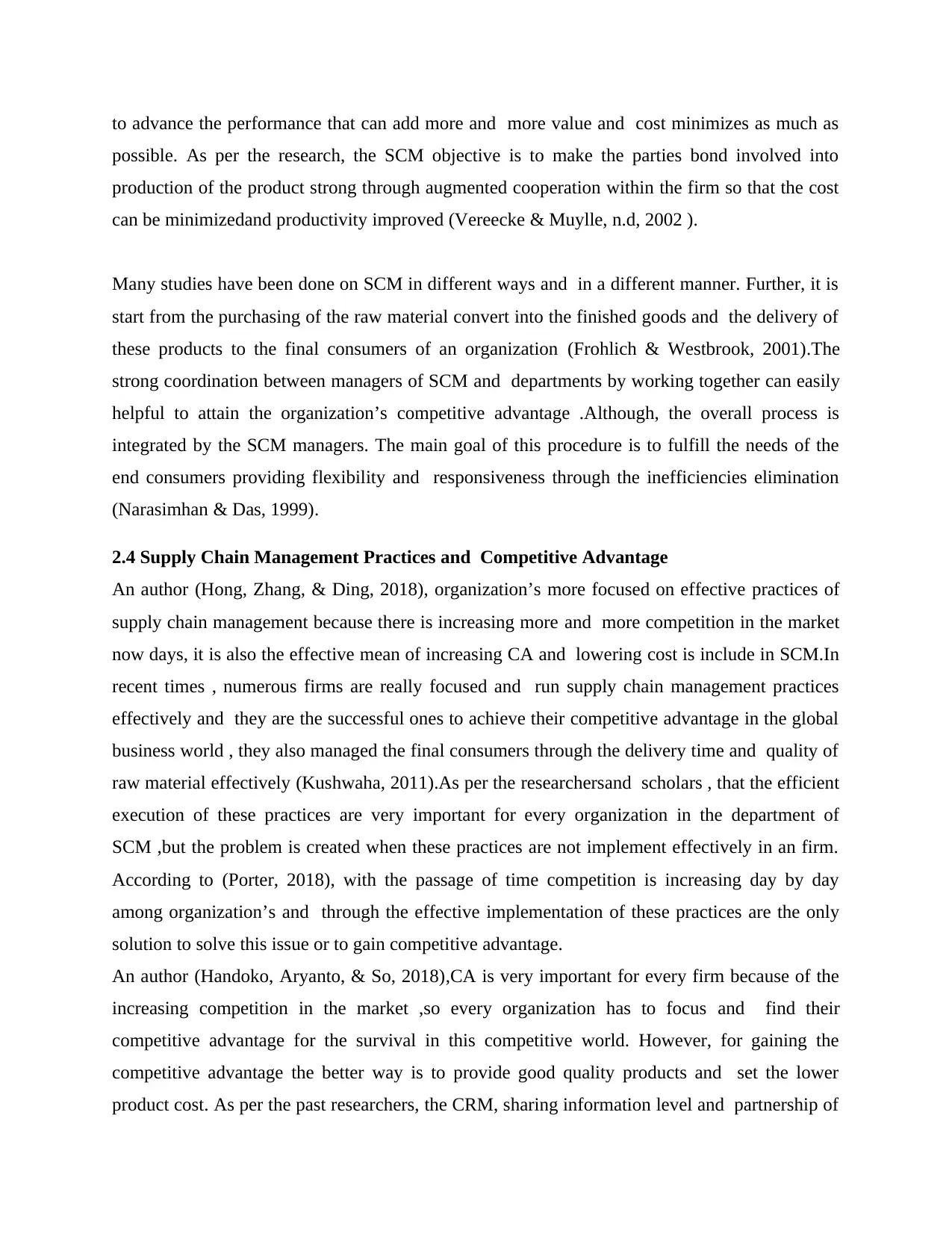
to advance the performance that can add more and more value and cost minimizes as much as
possible. As per the research, the SCM objective is to make the parties bond involved into
production of the product strong through augmented cooperation within the firm so that the cost
can be minimizedand productivity improved (Vereecke & Muylle, n.d, 2002 ).
Many studies have been done on SCM in different ways and in a different manner. Further, it is
start from the purchasing of the raw material convert into the finished goods and the delivery of
these products to the final consumers of an organization (Frohlich & Westbrook, 2001).The
strong coordination between managers of SCM and departments by working together can easily
helpful to attain the organization’s competitive advantage .Although, the overall process is
integrated by the SCM managers. The main goal of this procedure is to fulfill the needs of the
end consumers providing flexibility and responsiveness through the inefficiencies elimination
(Narasimhan & Das, 1999).
2.4 Supply Chain Management Practices and Competitive Advantage
An author (Hong, Zhang, & Ding, 2018), organization’s more focused on effective practices of
supply chain management because there is increasing more and more competition in the market
now days, it is also the effective mean of increasing CA and lowering cost is include in SCM.In
recent times , numerous firms are really focused and run supply chain management practices
effectively and they are the successful ones to achieve their competitive advantage in the global
business world , they also managed the final consumers through the delivery time and quality of
raw material effectively (Kushwaha, 2011).As per the researchersand scholars , that the efficient
execution of these practices are very important for every organization in the department of
SCM ,but the problem is created when these practices are not implement effectively in an firm.
According to (Porter, 2018), with the passage of time competition is increasing day by day
among organization’s and through the effective implementation of these practices are the only
solution to solve this issue or to gain competitive advantage.
An author (Handoko, Aryanto, & So, 2018),CA is very important for every firm because of the
increasing competition in the market ,so every organization has to focus and find their
competitive advantage for the survival in this competitive world. However, for gaining the
competitive advantage the better way is to provide good quality products and set the lower
product cost. As per the past researchers, the CRM, sharing information level and partnership of
possible. As per the research, the SCM objective is to make the parties bond involved into
production of the product strong through augmented cooperation within the firm so that the cost
can be minimizedand productivity improved (Vereecke & Muylle, n.d, 2002 ).
Many studies have been done on SCM in different ways and in a different manner. Further, it is
start from the purchasing of the raw material convert into the finished goods and the delivery of
these products to the final consumers of an organization (Frohlich & Westbrook, 2001).The
strong coordination between managers of SCM and departments by working together can easily
helpful to attain the organization’s competitive advantage .Although, the overall process is
integrated by the SCM managers. The main goal of this procedure is to fulfill the needs of the
end consumers providing flexibility and responsiveness through the inefficiencies elimination
(Narasimhan & Das, 1999).
2.4 Supply Chain Management Practices and Competitive Advantage
An author (Hong, Zhang, & Ding, 2018), organization’s more focused on effective practices of
supply chain management because there is increasing more and more competition in the market
now days, it is also the effective mean of increasing CA and lowering cost is include in SCM.In
recent times , numerous firms are really focused and run supply chain management practices
effectively and they are the successful ones to achieve their competitive advantage in the global
business world , they also managed the final consumers through the delivery time and quality of
raw material effectively (Kushwaha, 2011).As per the researchersand scholars , that the efficient
execution of these practices are very important for every organization in the department of
SCM ,but the problem is created when these practices are not implement effectively in an firm.
According to (Porter, 2018), with the passage of time competition is increasing day by day
among organization’s and through the effective implementation of these practices are the only
solution to solve this issue or to gain competitive advantage.
An author (Handoko, Aryanto, & So, 2018),CA is very important for every firm because of the
increasing competition in the market ,so every organization has to focus and find their
competitive advantage for the survival in this competitive world. However, for gaining the
competitive advantage the better way is to provide good quality products and set the lower
product cost. As per the past researchers, the CRM, sharing information level and partnership of
Secure Best Marks with AI Grader
Need help grading? Try our AI Grader for instant feedback on your assignments.
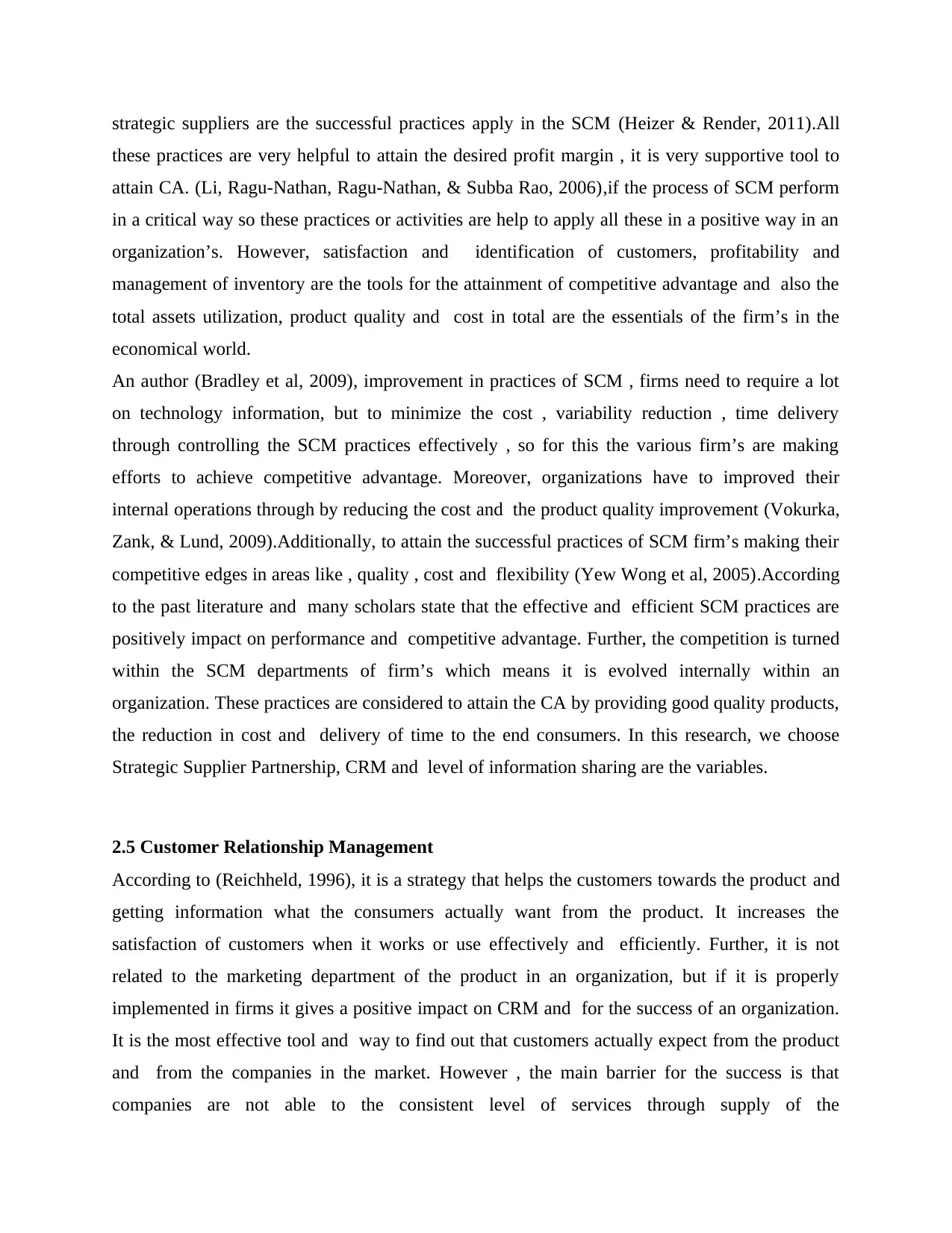
strategic suppliers are the successful practices apply in the SCM (Heizer & Render, 2011).All
these practices are very helpful to attain the desired profit margin , it is very supportive tool to
attain CA. (Li, Ragu-Nathan, Ragu-Nathan, & Subba Rao, 2006),if the process of SCM perform
in a critical way so these practices or activities are help to apply all these in a positive way in an
organization’s. However, satisfaction and identification of customers, profitability and
management of inventory are the tools for the attainment of competitive advantage and also the
total assets utilization, product quality and cost in total are the essentials of the firm’s in the
economical world.
An author (Bradley et al, 2009), improvement in practices of SCM , firms need to require a lot
on technology information, but to minimize the cost , variability reduction , time delivery
through controlling the SCM practices effectively , so for this the various firm’s are making
efforts to achieve competitive advantage. Moreover, organizations have to improved their
internal operations through by reducing the cost and the product quality improvement (Vokurka,
Zank, & Lund, 2009).Additionally, to attain the successful practices of SCM firm’s making their
competitive edges in areas like , quality , cost and flexibility (Yew Wong et al, 2005).According
to the past literature and many scholars state that the effective and efficient SCM practices are
positively impact on performance and competitive advantage. Further, the competition is turned
within the SCM departments of firm’s which means it is evolved internally within an
organization. These practices are considered to attain the CA by providing good quality products,
the reduction in cost and delivery of time to the end consumers. In this research, we choose
Strategic Supplier Partnership, CRM and level of information sharing are the variables.
2.5 Customer Relationship Management
According to (Reichheld, 1996), it is a strategy that helps the customers towards the product and
getting information what the consumers actually want from the product. It increases the
satisfaction of customers when it works or use effectively and efficiently. Further, it is not
related to the marketing department of the product in an organization, but if it is properly
implemented in firms it gives a positive impact on CRM and for the success of an organization.
It is the most effective tool and way to find out that customers actually expect from the product
and from the companies in the market. However , the main barrier for the success is that
companies are not able to the consistent level of services through supply of the
these practices are very helpful to attain the desired profit margin , it is very supportive tool to
attain CA. (Li, Ragu-Nathan, Ragu-Nathan, & Subba Rao, 2006),if the process of SCM perform
in a critical way so these practices or activities are help to apply all these in a positive way in an
organization’s. However, satisfaction and identification of customers, profitability and
management of inventory are the tools for the attainment of competitive advantage and also the
total assets utilization, product quality and cost in total are the essentials of the firm’s in the
economical world.
An author (Bradley et al, 2009), improvement in practices of SCM , firms need to require a lot
on technology information, but to minimize the cost , variability reduction , time delivery
through controlling the SCM practices effectively , so for this the various firm’s are making
efforts to achieve competitive advantage. Moreover, organizations have to improved their
internal operations through by reducing the cost and the product quality improvement (Vokurka,
Zank, & Lund, 2009).Additionally, to attain the successful practices of SCM firm’s making their
competitive edges in areas like , quality , cost and flexibility (Yew Wong et al, 2005).According
to the past literature and many scholars state that the effective and efficient SCM practices are
positively impact on performance and competitive advantage. Further, the competition is turned
within the SCM departments of firm’s which means it is evolved internally within an
organization. These practices are considered to attain the CA by providing good quality products,
the reduction in cost and delivery of time to the end consumers. In this research, we choose
Strategic Supplier Partnership, CRM and level of information sharing are the variables.
2.5 Customer Relationship Management
According to (Reichheld, 1996), it is a strategy that helps the customers towards the product and
getting information what the consumers actually want from the product. It increases the
satisfaction of customers when it works or use effectively and efficiently. Further, it is not
related to the marketing department of the product in an organization, but if it is properly
implemented in firms it gives a positive impact on CRM and for the success of an organization.
It is the most effective tool and way to find out that customers actually expect from the product
and from the companies in the market. However , the main barrier for the success is that
companies are not able to the consistent level of services through supply of the
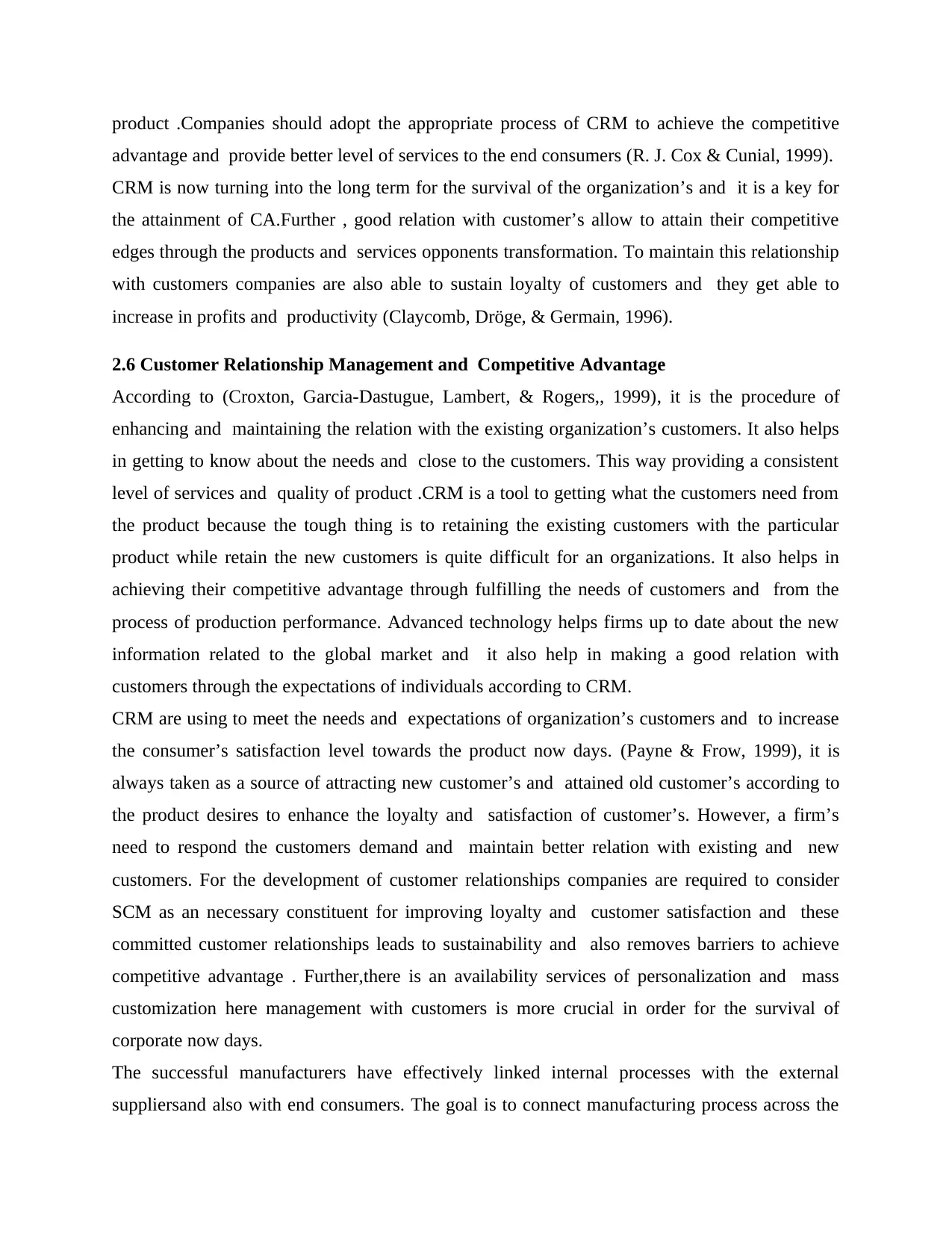
product .Companies should adopt the appropriate process of CRM to achieve the competitive
advantage and provide better level of services to the end consumers (R. J. Cox & Cunial, 1999).
CRM is now turning into the long term for the survival of the organization’s and it is a key for
the attainment of CA.Further , good relation with customer’s allow to attain their competitive
edges through the products and services opponents transformation. To maintain this relationship
with customers companies are also able to sustain loyalty of customers and they get able to
increase in profits and productivity (Claycomb, Dröge, & Germain, 1996).
2.6 Customer Relationship Management and Competitive Advantage
According to (Croxton, Garcia-Dastugue, Lambert, & Rogers,, 1999), it is the procedure of
enhancing and maintaining the relation with the existing organization’s customers. It also helps
in getting to know about the needs and close to the customers. This way providing a consistent
level of services and quality of product .CRM is a tool to getting what the customers need from
the product because the tough thing is to retaining the existing customers with the particular
product while retain the new customers is quite difficult for an organizations. It also helps in
achieving their competitive advantage through fulfilling the needs of customers and from the
process of production performance. Advanced technology helps firms up to date about the new
information related to the global market and it also help in making a good relation with
customers through the expectations of individuals according to CRM.
CRM are using to meet the needs and expectations of organization’s customers and to increase
the consumer’s satisfaction level towards the product now days. (Payne & Frow, 1999), it is
always taken as a source of attracting new customer’s and attained old customer’s according to
the product desires to enhance the loyalty and satisfaction of customer’s. However, a firm’s
need to respond the customers demand and maintain better relation with existing and new
customers. For the development of customer relationships companies are required to consider
SCM as an necessary constituent for improving loyalty and customer satisfaction and these
committed customer relationships leads to sustainability and also removes barriers to achieve
competitive advantage . Further,there is an availability services of personalization and mass
customization here management with customers is more crucial in order for the survival of
corporate now days.
The successful manufacturers have effectively linked internal processes with the external
suppliersand also with end consumers. The goal is to connect manufacturing process across the
advantage and provide better level of services to the end consumers (R. J. Cox & Cunial, 1999).
CRM is now turning into the long term for the survival of the organization’s and it is a key for
the attainment of CA.Further , good relation with customer’s allow to attain their competitive
edges through the products and services opponents transformation. To maintain this relationship
with customers companies are also able to sustain loyalty of customers and they get able to
increase in profits and productivity (Claycomb, Dröge, & Germain, 1996).
2.6 Customer Relationship Management and Competitive Advantage
According to (Croxton, Garcia-Dastugue, Lambert, & Rogers,, 1999), it is the procedure of
enhancing and maintaining the relation with the existing organization’s customers. It also helps
in getting to know about the needs and close to the customers. This way providing a consistent
level of services and quality of product .CRM is a tool to getting what the customers need from
the product because the tough thing is to retaining the existing customers with the particular
product while retain the new customers is quite difficult for an organizations. It also helps in
achieving their competitive advantage through fulfilling the needs of customers and from the
process of production performance. Advanced technology helps firms up to date about the new
information related to the global market and it also help in making a good relation with
customers through the expectations of individuals according to CRM.
CRM are using to meet the needs and expectations of organization’s customers and to increase
the consumer’s satisfaction level towards the product now days. (Payne & Frow, 1999), it is
always taken as a source of attracting new customer’s and attained old customer’s according to
the product desires to enhance the loyalty and satisfaction of customer’s. However, a firm’s
need to respond the customers demand and maintain better relation with existing and new
customers. For the development of customer relationships companies are required to consider
SCM as an necessary constituent for improving loyalty and customer satisfaction and these
committed customer relationships leads to sustainability and also removes barriers to achieve
competitive advantage . Further,there is an availability services of personalization and mass
customization here management with customers is more crucial in order for the survival of
corporate now days.
The successful manufacturers have effectively linked internal processes with the external
suppliersand also with end consumers. The goal is to connect manufacturing process across the
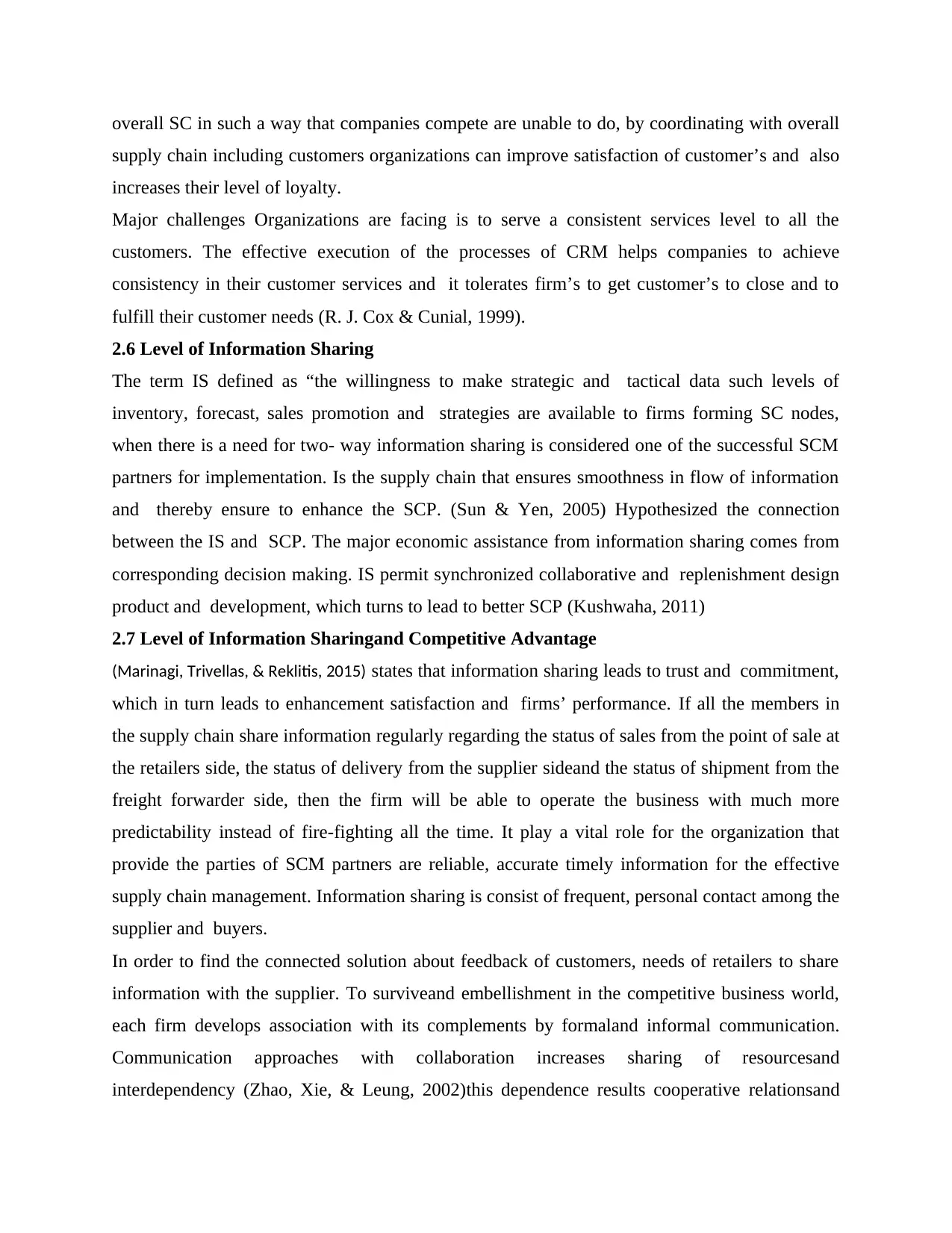
overall SC in such a way that companies compete are unable to do, by coordinating with overall
supply chain including customers organizations can improve satisfaction of customer’s and also
increases their level of loyalty.
Major challenges Organizations are facing is to serve a consistent services level to all the
customers. The effective execution of the processes of CRM helps companies to achieve
consistency in their customer services and it tolerates firm’s to get customer’s to close and to
fulfill their customer needs (R. J. Cox & Cunial, 1999).
2.6 Level of Information Sharing
The term IS defined as “the willingness to make strategic and tactical data such levels of
inventory, forecast, sales promotion and strategies are available to firms forming SC nodes,
when there is a need for two- way information sharing is considered one of the successful SCM
partners for implementation. Is the supply chain that ensures smoothness in flow of information
and thereby ensure to enhance the SCP. (Sun & Yen, 2005) Hypothesized the connection
between the IS and SCP. The major economic assistance from information sharing comes from
corresponding decision making. IS permit synchronized collaborative and replenishment design
product and development, which turns to lead to better SCP (Kushwaha, 2011)
2.7 Level of Information Sharingand Competitive Advantage
(Marinagi, Trivellas, & Reklitis, 2015) states that information sharing leads to trust and commitment,
which in turn leads to enhancement satisfaction and firms’ performance. If all the members in
the supply chain share information regularly regarding the status of sales from the point of sale at
the retailers side, the status of delivery from the supplier sideand the status of shipment from the
freight forwarder side, then the firm will be able to operate the business with much more
predictability instead of fire-fighting all the time. It play a vital role for the organization that
provide the parties of SCM partners are reliable, accurate timely information for the effective
supply chain management. Information sharing is consist of frequent, personal contact among the
supplier and buyers.
In order to find the connected solution about feedback of customers, needs of retailers to share
information with the supplier. To surviveand embellishment in the competitive business world,
each firm develops association with its complements by formaland informal communication.
Communication approaches with collaboration increases sharing of resourcesand
interdependency (Zhao, Xie, & Leung, 2002)this dependence results cooperative relationsand
supply chain including customers organizations can improve satisfaction of customer’s and also
increases their level of loyalty.
Major challenges Organizations are facing is to serve a consistent services level to all the
customers. The effective execution of the processes of CRM helps companies to achieve
consistency in their customer services and it tolerates firm’s to get customer’s to close and to
fulfill their customer needs (R. J. Cox & Cunial, 1999).
2.6 Level of Information Sharing
The term IS defined as “the willingness to make strategic and tactical data such levels of
inventory, forecast, sales promotion and strategies are available to firms forming SC nodes,
when there is a need for two- way information sharing is considered one of the successful SCM
partners for implementation. Is the supply chain that ensures smoothness in flow of information
and thereby ensure to enhance the SCP. (Sun & Yen, 2005) Hypothesized the connection
between the IS and SCP. The major economic assistance from information sharing comes from
corresponding decision making. IS permit synchronized collaborative and replenishment design
product and development, which turns to lead to better SCP (Kushwaha, 2011)
2.7 Level of Information Sharingand Competitive Advantage
(Marinagi, Trivellas, & Reklitis, 2015) states that information sharing leads to trust and commitment,
which in turn leads to enhancement satisfaction and firms’ performance. If all the members in
the supply chain share information regularly regarding the status of sales from the point of sale at
the retailers side, the status of delivery from the supplier sideand the status of shipment from the
freight forwarder side, then the firm will be able to operate the business with much more
predictability instead of fire-fighting all the time. It play a vital role for the organization that
provide the parties of SCM partners are reliable, accurate timely information for the effective
supply chain management. Information sharing is consist of frequent, personal contact among the
supplier and buyers.
In order to find the connected solution about feedback of customers, needs of retailers to share
information with the supplier. To surviveand embellishment in the competitive business world,
each firm develops association with its complements by formaland informal communication.
Communication approaches with collaboration increases sharing of resourcesand
interdependency (Zhao, Xie, & Leung, 2002)this dependence results cooperative relationsand
Paraphrase This Document
Need a fresh take? Get an instant paraphrase of this document with our AI Paraphraser
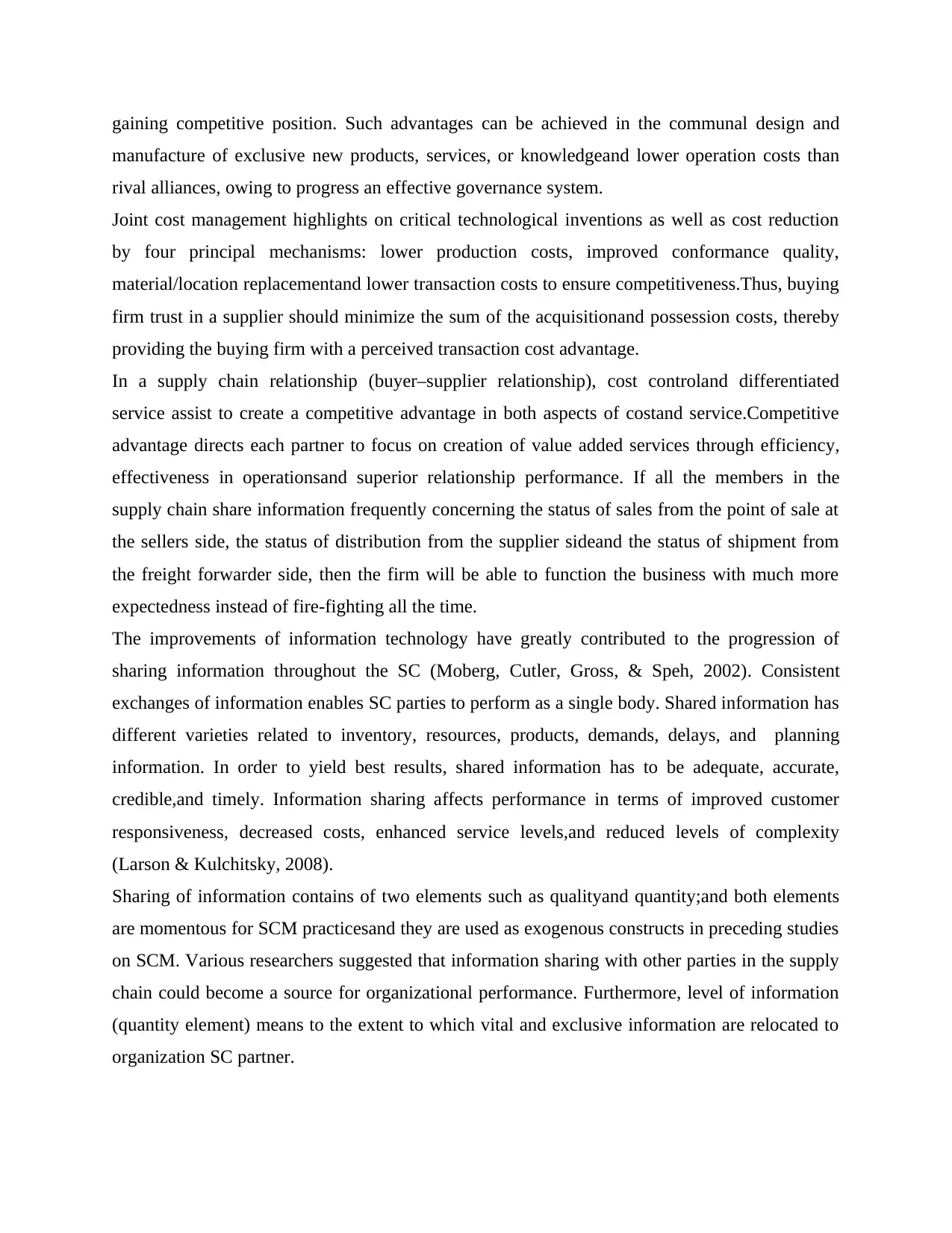
gaining competitive position. Such advantages can be achieved in the communal design and
manufacture of exclusive new products, services, or knowledgeand lower operation costs than
rival alliances, owing to progress an effective governance system.
Joint cost management highlights on critical technological inventions as well as cost reduction
by four principal mechanisms: lower production costs, improved conformance quality,
material/location replacementand lower transaction costs to ensure competitiveness.Thus, buying
firm trust in a supplier should minimize the sum of the acquisitionand possession costs, thereby
providing the buying firm with a perceived transaction cost advantage.
In a supply chain relationship (buyer–supplier relationship), cost controland differentiated
service assist to create a competitive advantage in both aspects of costand service.Competitive
advantage directs each partner to focus on creation of value added services through efficiency,
effectiveness in operationsand superior relationship performance. If all the members in the
supply chain share information frequently concerning the status of sales from the point of sale at
the sellers side, the status of distribution from the supplier sideand the status of shipment from
the freight forwarder side, then the firm will be able to function the business with much more
expectedness instead of fire-fighting all the time.
The improvements of information technology have greatly contributed to the progression of
sharing information throughout the SC (Moberg, Cutler, Gross, & Speh, 2002). Consistent
exchanges of information enables SC parties to perform as a single body. Shared information has
different varieties related to inventory, resources, products, demands, delays, and planning
information. In order to yield best results, shared information has to be adequate, accurate,
credible,and timely. Information sharing affects performance in terms of improved customer
responsiveness, decreased costs, enhanced service levels,and reduced levels of complexity
(Larson & Kulchitsky, 2008).
Sharing of information contains of two elements such as qualityand quantity;and both elements
are momentous for SCM practicesand they are used as exogenous constructs in preceding studies
on SCM. Various researchers suggested that information sharing with other parties in the supply
chain could become a source for organizational performance. Furthermore, level of information
(quantity element) means to the extent to which vital and exclusive information are relocated to
organization SC partner.
manufacture of exclusive new products, services, or knowledgeand lower operation costs than
rival alliances, owing to progress an effective governance system.
Joint cost management highlights on critical technological inventions as well as cost reduction
by four principal mechanisms: lower production costs, improved conformance quality,
material/location replacementand lower transaction costs to ensure competitiveness.Thus, buying
firm trust in a supplier should minimize the sum of the acquisitionand possession costs, thereby
providing the buying firm with a perceived transaction cost advantage.
In a supply chain relationship (buyer–supplier relationship), cost controland differentiated
service assist to create a competitive advantage in both aspects of costand service.Competitive
advantage directs each partner to focus on creation of value added services through efficiency,
effectiveness in operationsand superior relationship performance. If all the members in the
supply chain share information frequently concerning the status of sales from the point of sale at
the sellers side, the status of distribution from the supplier sideand the status of shipment from
the freight forwarder side, then the firm will be able to function the business with much more
expectedness instead of fire-fighting all the time.
The improvements of information technology have greatly contributed to the progression of
sharing information throughout the SC (Moberg, Cutler, Gross, & Speh, 2002). Consistent
exchanges of information enables SC parties to perform as a single body. Shared information has
different varieties related to inventory, resources, products, demands, delays, and planning
information. In order to yield best results, shared information has to be adequate, accurate,
credible,and timely. Information sharing affects performance in terms of improved customer
responsiveness, decreased costs, enhanced service levels,and reduced levels of complexity
(Larson & Kulchitsky, 2008).
Sharing of information contains of two elements such as qualityand quantity;and both elements
are momentous for SCM practicesand they are used as exogenous constructs in preceding studies
on SCM. Various researchers suggested that information sharing with other parties in the supply
chain could become a source for organizational performance. Furthermore, level of information
(quantity element) means to the extent to which vital and exclusive information are relocated to
organization SC partner.
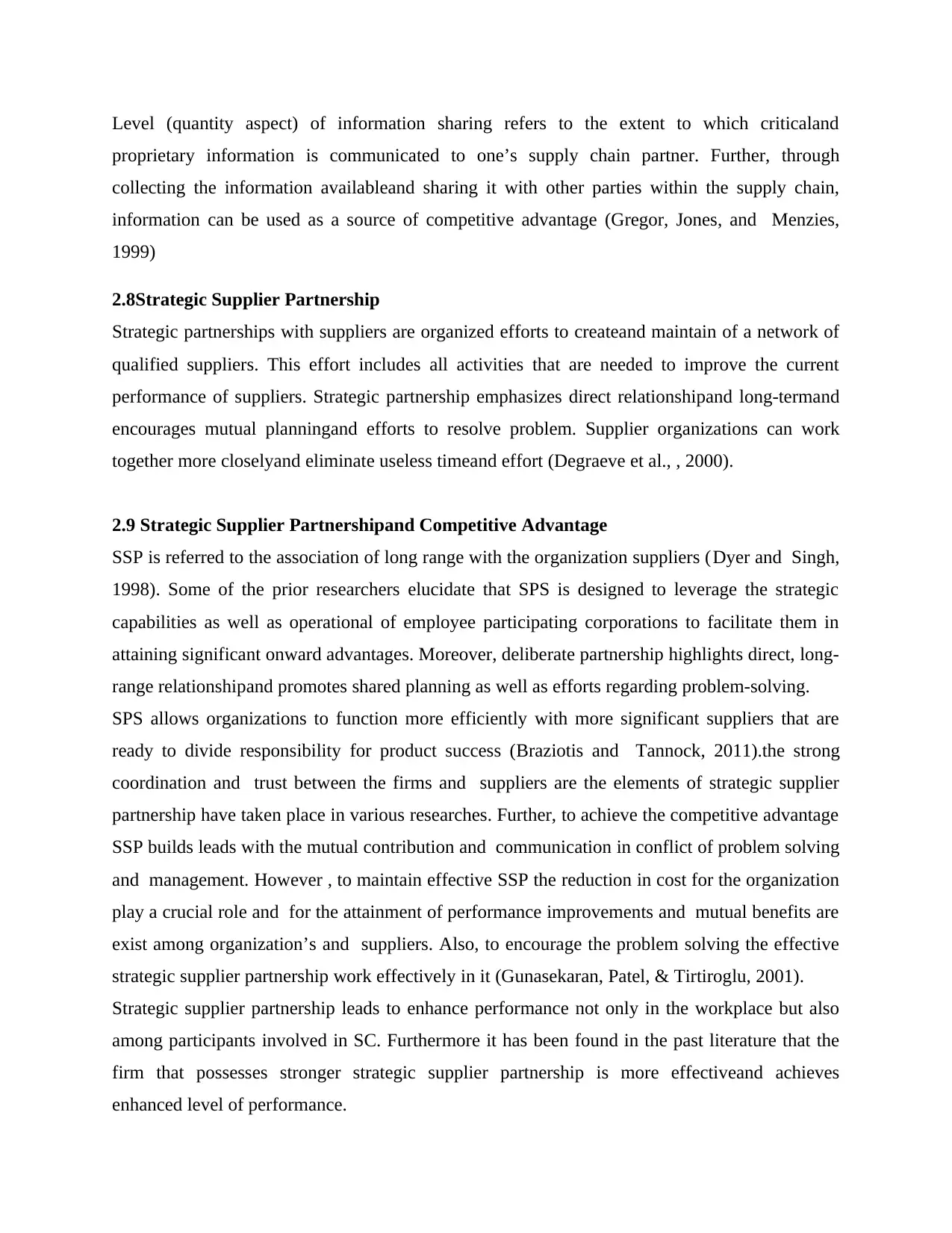
Level (quantity aspect) of information sharing refers to the extent to which criticaland
proprietary information is communicated to one’s supply chain partner. Further, through
collecting the information availableand sharing it with other parties within the supply chain,
information can be used as a source of competitive advantage (Gregor, Jones, and Menzies,
1999)
2.8Strategic Supplier Partnership
Strategic partnerships with suppliers are organized efforts to createand maintain of a network of
qualified suppliers. This effort includes all activities that are needed to improve the current
performance of suppliers. Strategic partnership emphasizes direct relationshipand long-termand
encourages mutual planningand efforts to resolve problem. Supplier organizations can work
together more closelyand eliminate useless timeand effort (Degraeve et al., , 2000).
2.9 Strategic Supplier Partnershipand Competitive Advantage
SSP is referred to the association of long range with the organization suppliers (Dyer and Singh,
1998). Some of the prior researchers elucidate that SPS is designed to leverage the strategic
capabilities as well as operational of employee participating corporations to facilitate them in
attaining significant onward advantages. Moreover, deliberate partnership highlights direct, long-
range relationshipand promotes shared planning as well as efforts regarding problem-solving.
SPS allows organizations to function more efficiently with more significant suppliers that are
ready to divide responsibility for product success (Braziotis and Tannock, 2011).the strong
coordination and trust between the firms and suppliers are the elements of strategic supplier
partnership have taken place in various researches. Further, to achieve the competitive advantage
SSP builds leads with the mutual contribution and communication in conflict of problem solving
and management. However , to maintain effective SSP the reduction in cost for the organization
play a crucial role and for the attainment of performance improvements and mutual benefits are
exist among organization’s and suppliers. Also, to encourage the problem solving the effective
strategic supplier partnership work effectively in it (Gunasekaran, Patel, & Tirtiroglu, 2001).
Strategic supplier partnership leads to enhance performance not only in the workplace but also
among participants involved in SC. Furthermore it has been found in the past literature that the
firm that possesses stronger strategic supplier partnership is more effectiveand achieves
enhanced level of performance.
proprietary information is communicated to one’s supply chain partner. Further, through
collecting the information availableand sharing it with other parties within the supply chain,
information can be used as a source of competitive advantage (Gregor, Jones, and Menzies,
1999)
2.8Strategic Supplier Partnership
Strategic partnerships with suppliers are organized efforts to createand maintain of a network of
qualified suppliers. This effort includes all activities that are needed to improve the current
performance of suppliers. Strategic partnership emphasizes direct relationshipand long-termand
encourages mutual planningand efforts to resolve problem. Supplier organizations can work
together more closelyand eliminate useless timeand effort (Degraeve et al., , 2000).
2.9 Strategic Supplier Partnershipand Competitive Advantage
SSP is referred to the association of long range with the organization suppliers (Dyer and Singh,
1998). Some of the prior researchers elucidate that SPS is designed to leverage the strategic
capabilities as well as operational of employee participating corporations to facilitate them in
attaining significant onward advantages. Moreover, deliberate partnership highlights direct, long-
range relationshipand promotes shared planning as well as efforts regarding problem-solving.
SPS allows organizations to function more efficiently with more significant suppliers that are
ready to divide responsibility for product success (Braziotis and Tannock, 2011).the strong
coordination and trust between the firms and suppliers are the elements of strategic supplier
partnership have taken place in various researches. Further, to achieve the competitive advantage
SSP builds leads with the mutual contribution and communication in conflict of problem solving
and management. However , to maintain effective SSP the reduction in cost for the organization
play a crucial role and for the attainment of performance improvements and mutual benefits are
exist among organization’s and suppliers. Also, to encourage the problem solving the effective
strategic supplier partnership work effectively in it (Gunasekaran, Patel, & Tirtiroglu, 2001).
Strategic supplier partnership leads to enhance performance not only in the workplace but also
among participants involved in SC. Furthermore it has been found in the past literature that the
firm that possesses stronger strategic supplier partnership is more effectiveand achieves
enhanced level of performance.
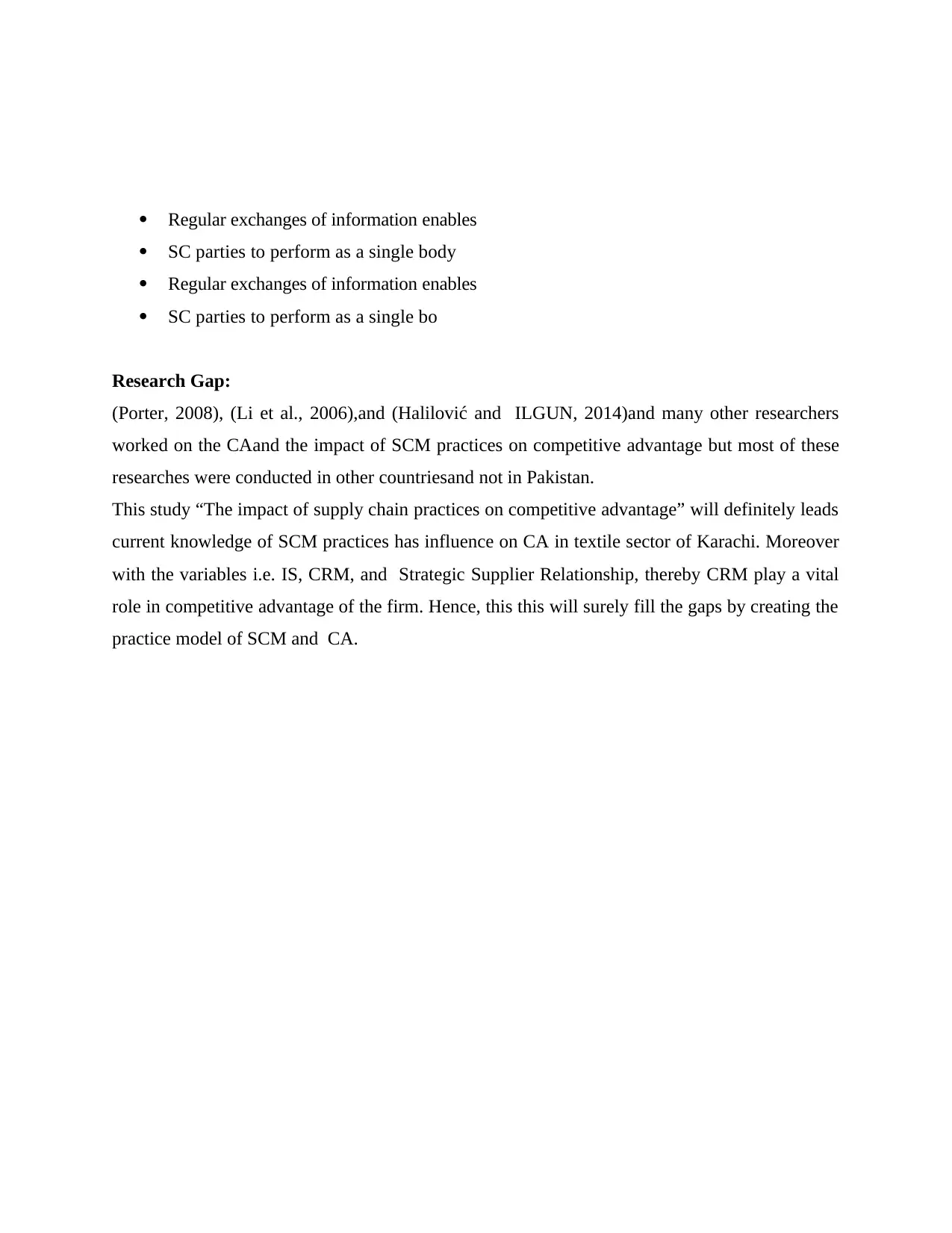
Regular exchanges of information enables
SC parties to perform as a single body
Regular exchanges of information enables
SC parties to perform as a single bo
Research Gap:
(Porter, 2008), (Li et al., 2006),and (Halilović and ILGUN, 2014)and many other researchers
worked on the CAand the impact of SCM practices on competitive advantage but most of these
researches were conducted in other countriesand not in Pakistan.
This study “The impact of supply chain practices on competitive advantage” will definitely leads
current knowledge of SCM practices has influence on CA in textile sector of Karachi. Moreover
with the variables i.e. IS, CRM, and Strategic Supplier Relationship, thereby CRM play a vital
role in competitive advantage of the firm. Hence, this this will surely fill the gaps by creating the
practice model of SCM and CA.
SC parties to perform as a single body
Regular exchanges of information enables
SC parties to perform as a single bo
Research Gap:
(Porter, 2008), (Li et al., 2006),and (Halilović and ILGUN, 2014)and many other researchers
worked on the CAand the impact of SCM practices on competitive advantage but most of these
researches were conducted in other countriesand not in Pakistan.
This study “The impact of supply chain practices on competitive advantage” will definitely leads
current knowledge of SCM practices has influence on CA in textile sector of Karachi. Moreover
with the variables i.e. IS, CRM, and Strategic Supplier Relationship, thereby CRM play a vital
role in competitive advantage of the firm. Hence, this this will surely fill the gaps by creating the
practice model of SCM and CA.
Secure Best Marks with AI Grader
Need help grading? Try our AI Grader for instant feedback on your assignments.
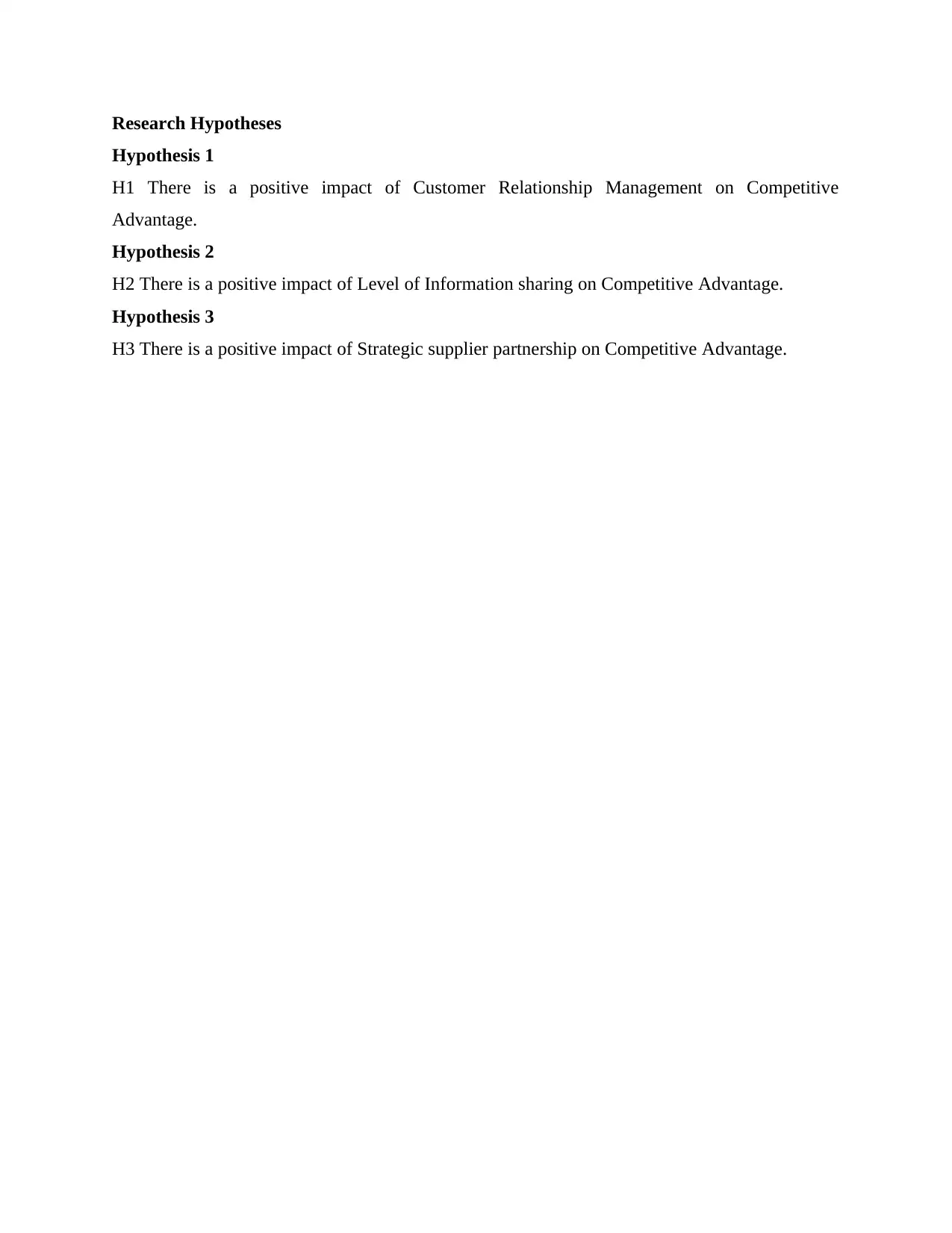
Research Hypotheses
Hypothesis 1
H1 There is a positive impact of Customer Relationship Management on Competitive
Advantage.
Hypothesis 2
H2 There is a positive impact of Level of Information sharing on Competitive Advantage.
Hypothesis 3
H3 There is a positive impact of Strategic supplier partnership on Competitive Advantage.
Hypothesis 1
H1 There is a positive impact of Customer Relationship Management on Competitive
Advantage.
Hypothesis 2
H2 There is a positive impact of Level of Information sharing on Competitive Advantage.
Hypothesis 3
H3 There is a positive impact of Strategic supplier partnership on Competitive Advantage.
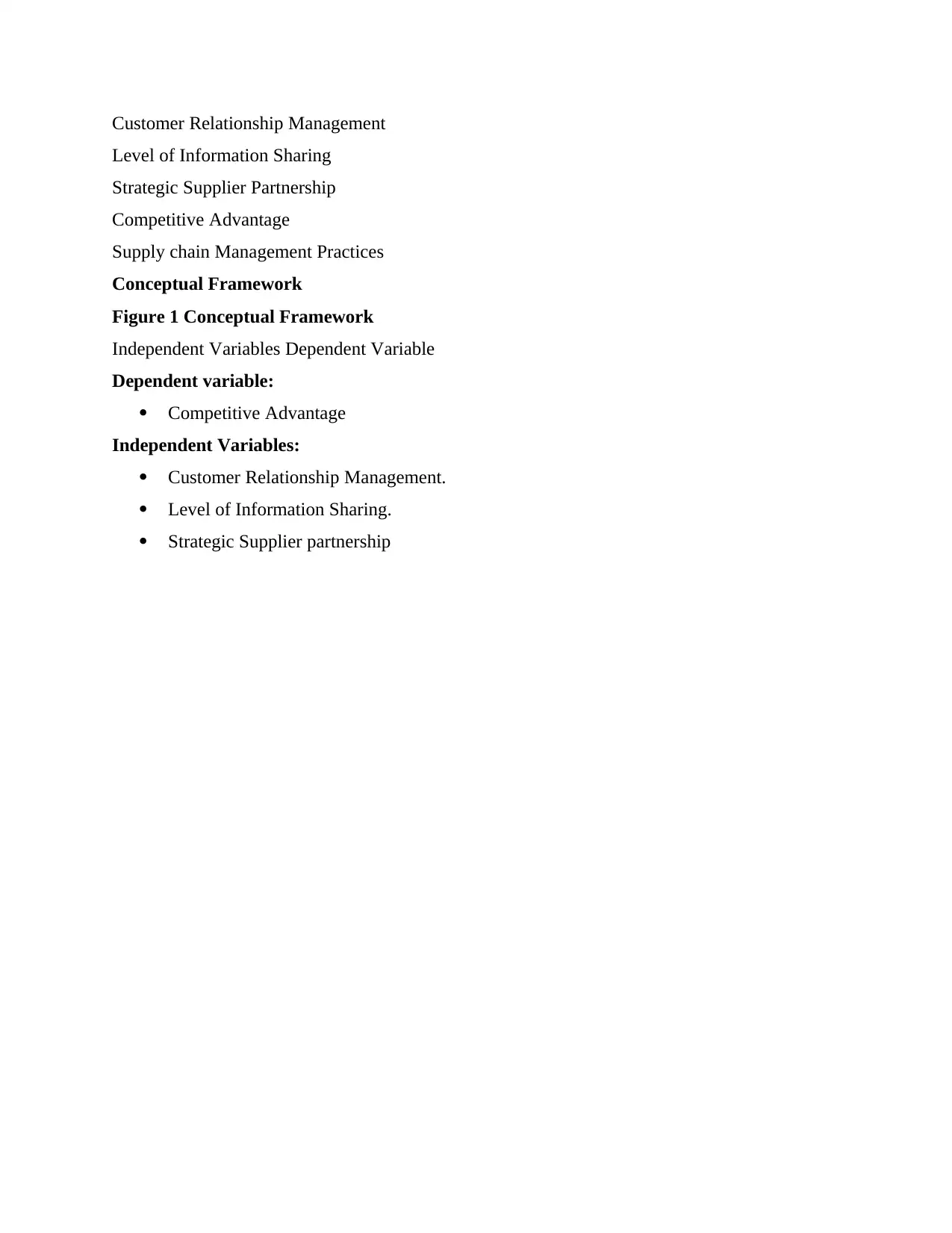
Customer Relationship Management
Level of Information Sharing
Strategic Supplier Partnership
Competitive Advantage
Supply chain Management Practices
Conceptual Framework
Figure 1 Conceptual Framework
Independent Variables Dependent Variable
Dependent variable:
Competitive Advantage
Independent Variables:
Customer Relationship Management.
Level of Information Sharing.
Strategic Supplier partnership
Level of Information Sharing
Strategic Supplier Partnership
Competitive Advantage
Supply chain Management Practices
Conceptual Framework
Figure 1 Conceptual Framework
Independent Variables Dependent Variable
Dependent variable:
Competitive Advantage
Independent Variables:
Customer Relationship Management.
Level of Information Sharing.
Strategic Supplier partnership
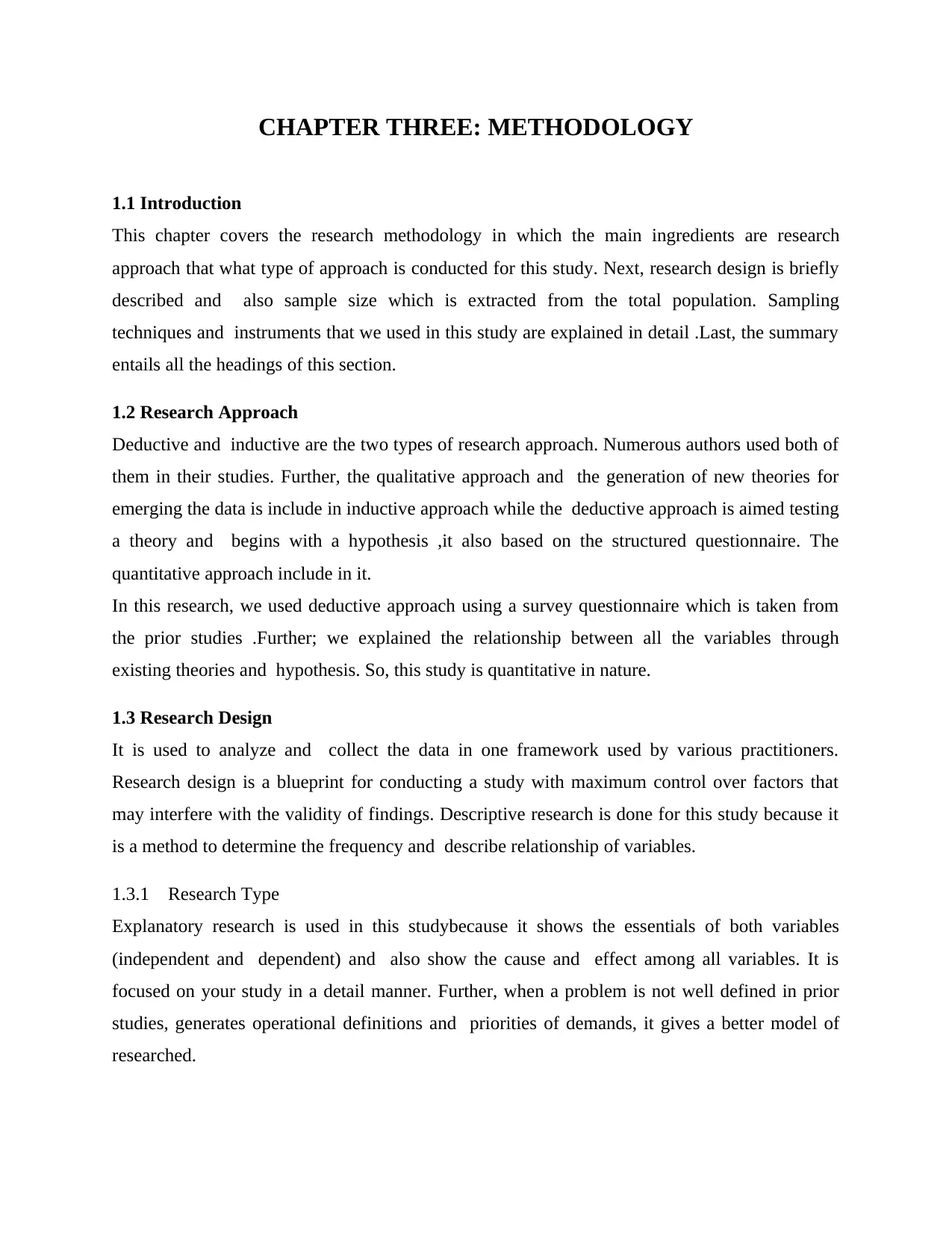
CHAPTER THREE: METHODOLOGY
1.1 Introduction
This chapter covers the research methodology in which the main ingredients are research
approach that what type of approach is conducted for this study. Next, research design is briefly
described and also sample size which is extracted from the total population. Sampling
techniques and instruments that we used in this study are explained in detail .Last, the summary
entails all the headings of this section.
1.2 Research Approach
Deductive and inductive are the two types of research approach. Numerous authors used both of
them in their studies. Further, the qualitative approach and the generation of new theories for
emerging the data is include in inductive approach while the deductive approach is aimed testing
a theory and begins with a hypothesis ,it also based on the structured questionnaire. The
quantitative approach include in it.
In this research, we used deductive approach using a survey questionnaire which is taken from
the prior studies .Further; we explained the relationship between all the variables through
existing theories and hypothesis. So, this study is quantitative in nature.
1.3 Research Design
It is used to analyze and collect the data in one framework used by various practitioners.
Research design is a blueprint for conducting a study with maximum control over factors that
may interfere with the validity of findings. Descriptive research is done for this study because it
is a method to determine the frequency and describe relationship of variables.
1.3.1 Research Type
Explanatory research is used in this studybecause it shows the essentials of both variables
(independent and dependent) and also show the cause and effect among all variables. It is
focused on your study in a detail manner. Further, when a problem is not well defined in prior
studies, generates operational definitions and priorities of demands, it gives a better model of
researched.
1.1 Introduction
This chapter covers the research methodology in which the main ingredients are research
approach that what type of approach is conducted for this study. Next, research design is briefly
described and also sample size which is extracted from the total population. Sampling
techniques and instruments that we used in this study are explained in detail .Last, the summary
entails all the headings of this section.
1.2 Research Approach
Deductive and inductive are the two types of research approach. Numerous authors used both of
them in their studies. Further, the qualitative approach and the generation of new theories for
emerging the data is include in inductive approach while the deductive approach is aimed testing
a theory and begins with a hypothesis ,it also based on the structured questionnaire. The
quantitative approach include in it.
In this research, we used deductive approach using a survey questionnaire which is taken from
the prior studies .Further; we explained the relationship between all the variables through
existing theories and hypothesis. So, this study is quantitative in nature.
1.3 Research Design
It is used to analyze and collect the data in one framework used by various practitioners.
Research design is a blueprint for conducting a study with maximum control over factors that
may interfere with the validity of findings. Descriptive research is done for this study because it
is a method to determine the frequency and describe relationship of variables.
1.3.1 Research Type
Explanatory research is used in this studybecause it shows the essentials of both variables
(independent and dependent) and also show the cause and effect among all variables. It is
focused on your study in a detail manner. Further, when a problem is not well defined in prior
studies, generates operational definitions and priorities of demands, it gives a better model of
researched.
Paraphrase This Document
Need a fresh take? Get an instant paraphrase of this document with our AI Paraphraser
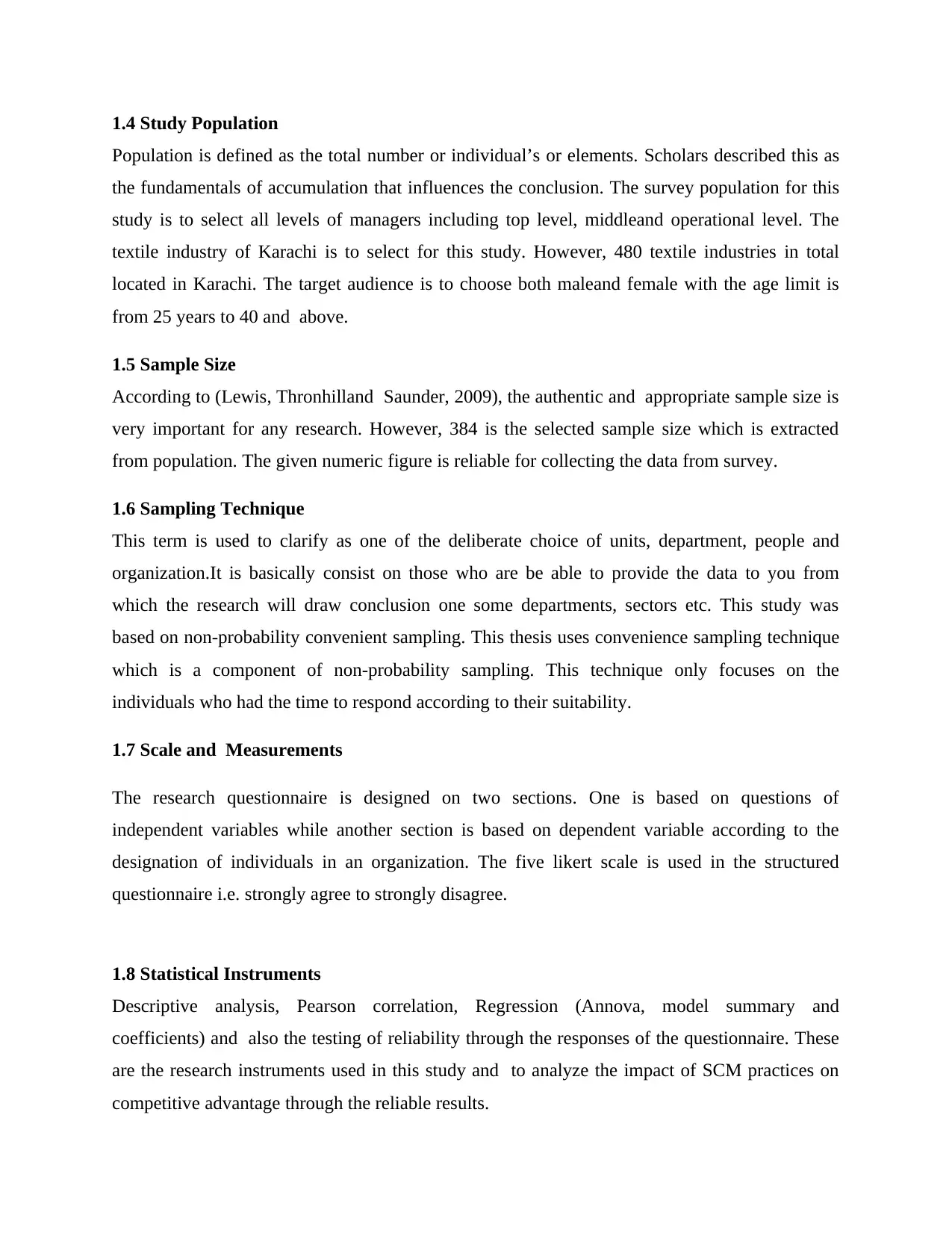
1.4 Study Population
Population is defined as the total number or individual’s or elements. Scholars described this as
the fundamentals of accumulation that influences the conclusion. The survey population for this
study is to select all levels of managers including top level, middleand operational level. The
textile industry of Karachi is to select for this study. However, 480 textile industries in total
located in Karachi. The target audience is to choose both maleand female with the age limit is
from 25 years to 40 and above.
1.5 Sample Size
According to (Lewis, Thronhilland Saunder, 2009), the authentic and appropriate sample size is
very important for any research. However, 384 is the selected sample size which is extracted
from population. The given numeric figure is reliable for collecting the data from survey.
1.6 Sampling Technique
This term is used to clarify as one of the deliberate choice of units, department, people and
organization.It is basically consist on those who are be able to provide the data to you from
which the research will draw conclusion one some departments, sectors etc. This study was
based on non-probability convenient sampling. This thesis uses convenience sampling technique
which is a component of non-probability sampling. This technique only focuses on the
individuals who had the time to respond according to their suitability.
1.7 Scale and Measurements
The research questionnaire is designed on two sections. One is based on questions of
independent variables while another section is based on dependent variable according to the
designation of individuals in an organization. The five likert scale is used in the structured
questionnaire i.e. strongly agree to strongly disagree.
1.8 Statistical Instruments
Descriptive analysis, Pearson correlation, Regression (Annova, model summary and
coefficients) and also the testing of reliability through the responses of the questionnaire. These
are the research instruments used in this study and to analyze the impact of SCM practices on
competitive advantage through the reliable results.
Population is defined as the total number or individual’s or elements. Scholars described this as
the fundamentals of accumulation that influences the conclusion. The survey population for this
study is to select all levels of managers including top level, middleand operational level. The
textile industry of Karachi is to select for this study. However, 480 textile industries in total
located in Karachi. The target audience is to choose both maleand female with the age limit is
from 25 years to 40 and above.
1.5 Sample Size
According to (Lewis, Thronhilland Saunder, 2009), the authentic and appropriate sample size is
very important for any research. However, 384 is the selected sample size which is extracted
from population. The given numeric figure is reliable for collecting the data from survey.
1.6 Sampling Technique
This term is used to clarify as one of the deliberate choice of units, department, people and
organization.It is basically consist on those who are be able to provide the data to you from
which the research will draw conclusion one some departments, sectors etc. This study was
based on non-probability convenient sampling. This thesis uses convenience sampling technique
which is a component of non-probability sampling. This technique only focuses on the
individuals who had the time to respond according to their suitability.
1.7 Scale and Measurements
The research questionnaire is designed on two sections. One is based on questions of
independent variables while another section is based on dependent variable according to the
designation of individuals in an organization. The five likert scale is used in the structured
questionnaire i.e. strongly agree to strongly disagree.
1.8 Statistical Instruments
Descriptive analysis, Pearson correlation, Regression (Annova, model summary and
coefficients) and also the testing of reliability through the responses of the questionnaire. These
are the research instruments used in this study and to analyze the impact of SCM practices on
competitive advantage through the reliable results.
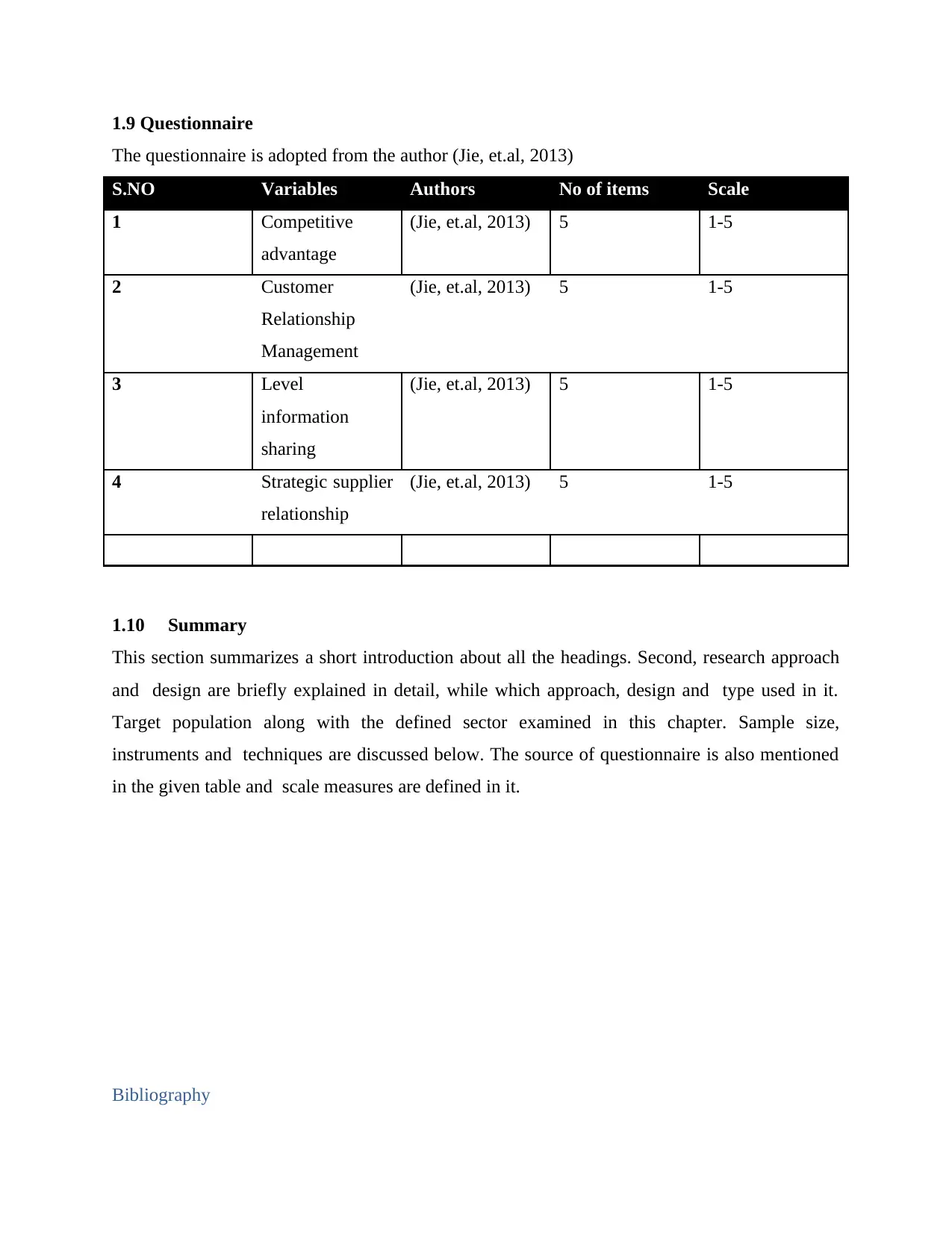
1.9 Questionnaire
The questionnaire is adopted from the author (Jie, et.al, 2013)
S.NO Variables Authors No of items Scale
1 Competitive
advantage
(Jie, et.al, 2013) 5 1-5
2 Customer
Relationship
Management
(Jie, et.al, 2013) 5 1-5
3 Level
information
sharing
(Jie, et.al, 2013) 5 1-5
4 Strategic supplier
relationship
(Jie, et.al, 2013) 5 1-5
1.10 Summary
This section summarizes a short introduction about all the headings. Second, research approach
and design are briefly explained in detail, while which approach, design and type used in it.
Target population along with the defined sector examined in this chapter. Sample size,
instruments and techniques are discussed below. The source of questionnaire is also mentioned
in the given table and scale measures are defined in it.
Bibliography
The questionnaire is adopted from the author (Jie, et.al, 2013)
S.NO Variables Authors No of items Scale
1 Competitive
advantage
(Jie, et.al, 2013) 5 1-5
2 Customer
Relationship
Management
(Jie, et.al, 2013) 5 1-5
3 Level
information
sharing
(Jie, et.al, 2013) 5 1-5
4 Strategic supplier
relationship
(Jie, et.al, 2013) 5 1-5
1.10 Summary
This section summarizes a short introduction about all the headings. Second, research approach
and design are briefly explained in detail, while which approach, design and type used in it.
Target population along with the defined sector examined in this chapter. Sample size,
instruments and techniques are discussed below. The source of questionnaire is also mentioned
in the given table and scale measures are defined in it.
Bibliography
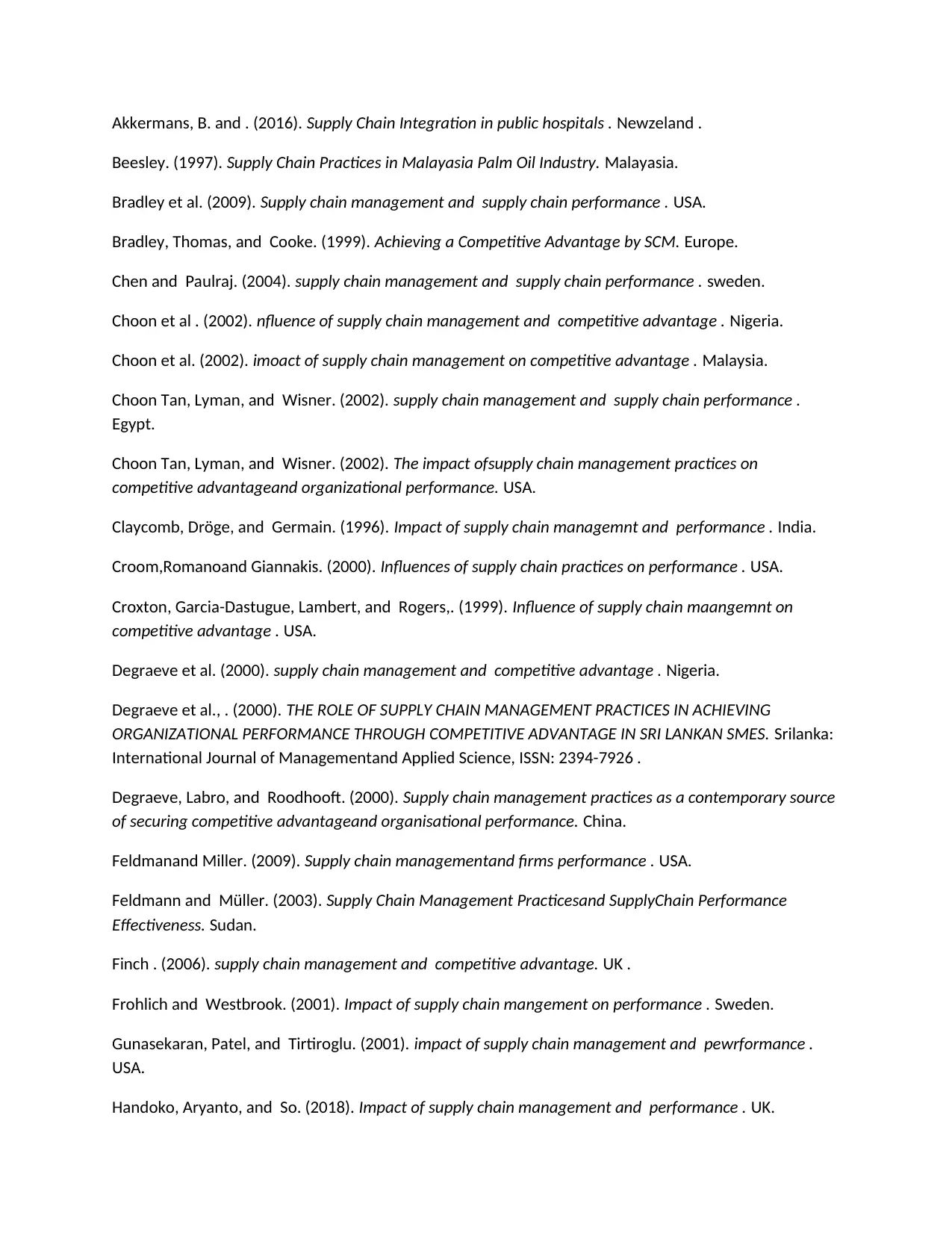
Akkermans, B. and . (2016). Supply Chain Integration in public hospitals . Newzeland .
Beesley. (1997). Supply Chain Practices in Malayasia Palm Oil Industry. Malayasia.
Bradley et al. (2009). Supply chain management and supply chain performance . USA.
Bradley, Thomas, and Cooke. (1999). Achieving a Competitive Advantage by SCM. Europe.
Chen and Paulraj. (2004). supply chain management and supply chain performance . sweden.
Choon et al . (2002). nfluence of supply chain management and competitive advantage . Nigeria.
Choon et al. (2002). imoact of supply chain management on competitive advantage . Malaysia.
Choon Tan, Lyman, and Wisner. (2002). supply chain management and supply chain performance .
Egypt.
Choon Tan, Lyman, and Wisner. (2002). The impact ofsupply chain management practices on
competitive advantageand organizational performance. USA.
Claycomb, Dröge, and Germain. (1996). Impact of supply chain managemnt and performance . India.
Croom,Romanoand Giannakis. (2000). Influences of supply chain practices on performance . USA.
Croxton, Garcia-Dastugue, Lambert, and Rogers,. (1999). Influence of supply chain maangemnt on
competitive advantage . USA.
Degraeve et al. (2000). supply chain management and competitive advantage . Nigeria.
Degraeve et al., . (2000). THE ROLE OF SUPPLY CHAIN MANAGEMENT PRACTICES IN ACHIEVING
ORGANIZATIONAL PERFORMANCE THROUGH COMPETITIVE ADVANTAGE IN SRI LANKAN SMES. Srilanka:
International Journal of Managementand Applied Science, ISSN: 2394-7926 .
Degraeve, Labro, and Roodhooft. (2000). Supply chain management practices as a contemporary source
of securing competitive advantageand organisational performance. China.
Feldmanand Miller. (2009). Supply chain managementand firms performance . USA.
Feldmann and Müller. (2003). Supply Chain Management Practicesand SupplyChain Performance
Effectiveness. Sudan.
Finch . (2006). supply chain management and competitive advantage. UK .
Frohlich and Westbrook. (2001). Impact of supply chain mangement on performance . Sweden.
Gunasekaran, Patel, and Tirtiroglu. (2001). impact of supply chain management and pewrformance .
USA.
Handoko, Aryanto, and So. (2018). Impact of supply chain management and performance . UK.
Beesley. (1997). Supply Chain Practices in Malayasia Palm Oil Industry. Malayasia.
Bradley et al. (2009). Supply chain management and supply chain performance . USA.
Bradley, Thomas, and Cooke. (1999). Achieving a Competitive Advantage by SCM. Europe.
Chen and Paulraj. (2004). supply chain management and supply chain performance . sweden.
Choon et al . (2002). nfluence of supply chain management and competitive advantage . Nigeria.
Choon et al. (2002). imoact of supply chain management on competitive advantage . Malaysia.
Choon Tan, Lyman, and Wisner. (2002). supply chain management and supply chain performance .
Egypt.
Choon Tan, Lyman, and Wisner. (2002). The impact ofsupply chain management practices on
competitive advantageand organizational performance. USA.
Claycomb, Dröge, and Germain. (1996). Impact of supply chain managemnt and performance . India.
Croom,Romanoand Giannakis. (2000). Influences of supply chain practices on performance . USA.
Croxton, Garcia-Dastugue, Lambert, and Rogers,. (1999). Influence of supply chain maangemnt on
competitive advantage . USA.
Degraeve et al. (2000). supply chain management and competitive advantage . Nigeria.
Degraeve et al., . (2000). THE ROLE OF SUPPLY CHAIN MANAGEMENT PRACTICES IN ACHIEVING
ORGANIZATIONAL PERFORMANCE THROUGH COMPETITIVE ADVANTAGE IN SRI LANKAN SMES. Srilanka:
International Journal of Managementand Applied Science, ISSN: 2394-7926 .
Degraeve, Labro, and Roodhooft. (2000). Supply chain management practices as a contemporary source
of securing competitive advantageand organisational performance. China.
Feldmanand Miller. (2009). Supply chain managementand firms performance . USA.
Feldmann and Müller. (2003). Supply Chain Management Practicesand SupplyChain Performance
Effectiveness. Sudan.
Finch . (2006). supply chain management and competitive advantage. UK .
Frohlich and Westbrook. (2001). Impact of supply chain mangement on performance . Sweden.
Gunasekaran, Patel, and Tirtiroglu. (2001). impact of supply chain management and pewrformance .
USA.
Handoko, Aryanto, and So. (2018). Impact of supply chain management and performance . UK.
Secure Best Marks with AI Grader
Need help grading? Try our AI Grader for instant feedback on your assignments.
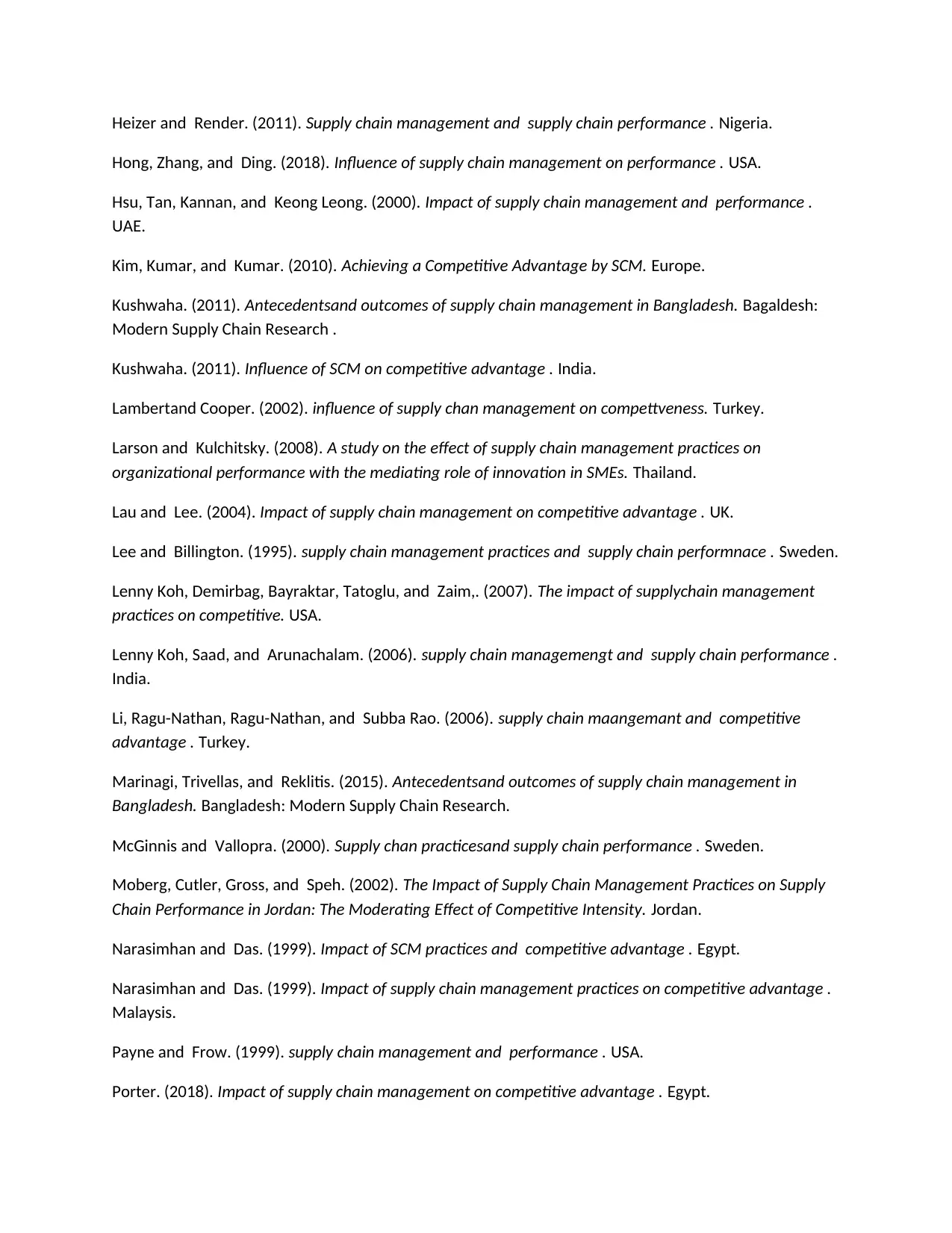
Heizer and Render. (2011). Supply chain management and supply chain performance . Nigeria.
Hong, Zhang, and Ding. (2018). Influence of supply chain management on performance . USA.
Hsu, Tan, Kannan, and Keong Leong. (2000). Impact of supply chain management and performance .
UAE.
Kim, Kumar, and Kumar. (2010). Achieving a Competitive Advantage by SCM. Europe.
Kushwaha. (2011). Antecedentsand outcomes of supply chain management in Bangladesh. Bagaldesh:
Modern Supply Chain Research .
Kushwaha. (2011). Influence of SCM on competitive advantage . India.
Lambertand Cooper. (2002). influence of supply chan management on compettveness. Turkey.
Larson and Kulchitsky. (2008). A study on the effect of supply chain management practices on
organizational performance with the mediating role of innovation in SMEs. Thailand.
Lau and Lee. (2004). Impact of supply chain management on competitive advantage . UK.
Lee and Billington. (1995). supply chain management practices and supply chain performnace . Sweden.
Lenny Koh, Demirbag, Bayraktar, Tatoglu, and Zaim,. (2007). The impact of supplychain management
practices on competitive. USA.
Lenny Koh, Saad, and Arunachalam. (2006). supply chain managemengt and supply chain performance .
India.
Li, Ragu-Nathan, Ragu-Nathan, and Subba Rao. (2006). supply chain maangemant and competitive
advantage . Turkey.
Marinagi, Trivellas, and Reklitis. (2015). Antecedentsand outcomes of supply chain management in
Bangladesh. Bangladesh: Modern Supply Chain Research.
McGinnis and Vallopra. (2000). Supply chan practicesand supply chain performance . Sweden.
Moberg, Cutler, Gross, and Speh. (2002). The Impact of Supply Chain Management Practices on Supply
Chain Performance in Jordan: The Moderating Effect of Competitive Intensity. Jordan.
Narasimhan and Das. (1999). Impact of SCM practices and competitive advantage . Egypt.
Narasimhan and Das. (1999). Impact of supply chain management practices on competitive advantage .
Malaysis.
Payne and Frow. (1999). supply chain management and performance . USA.
Porter. (2018). Impact of supply chain management on competitive advantage . Egypt.
Hong, Zhang, and Ding. (2018). Influence of supply chain management on performance . USA.
Hsu, Tan, Kannan, and Keong Leong. (2000). Impact of supply chain management and performance .
UAE.
Kim, Kumar, and Kumar. (2010). Achieving a Competitive Advantage by SCM. Europe.
Kushwaha. (2011). Antecedentsand outcomes of supply chain management in Bangladesh. Bagaldesh:
Modern Supply Chain Research .
Kushwaha. (2011). Influence of SCM on competitive advantage . India.
Lambertand Cooper. (2002). influence of supply chan management on compettveness. Turkey.
Larson and Kulchitsky. (2008). A study on the effect of supply chain management practices on
organizational performance with the mediating role of innovation in SMEs. Thailand.
Lau and Lee. (2004). Impact of supply chain management on competitive advantage . UK.
Lee and Billington. (1995). supply chain management practices and supply chain performnace . Sweden.
Lenny Koh, Demirbag, Bayraktar, Tatoglu, and Zaim,. (2007). The impact of supplychain management
practices on competitive. USA.
Lenny Koh, Saad, and Arunachalam. (2006). supply chain managemengt and supply chain performance .
India.
Li, Ragu-Nathan, Ragu-Nathan, and Subba Rao. (2006). supply chain maangemant and competitive
advantage . Turkey.
Marinagi, Trivellas, and Reklitis. (2015). Antecedentsand outcomes of supply chain management in
Bangladesh. Bangladesh: Modern Supply Chain Research.
McGinnis and Vallopra. (2000). Supply chan practicesand supply chain performance . Sweden.
Moberg, Cutler, Gross, and Speh. (2002). The Impact of Supply Chain Management Practices on Supply
Chain Performance in Jordan: The Moderating Effect of Competitive Intensity. Jordan.
Narasimhan and Das. (1999). Impact of SCM practices and competitive advantage . Egypt.
Narasimhan and Das. (1999). Impact of supply chain management practices on competitive advantage .
Malaysis.
Payne and Frow. (1999). supply chain management and performance . USA.
Porter. (2018). Impact of supply chain management on competitive advantage . Egypt.
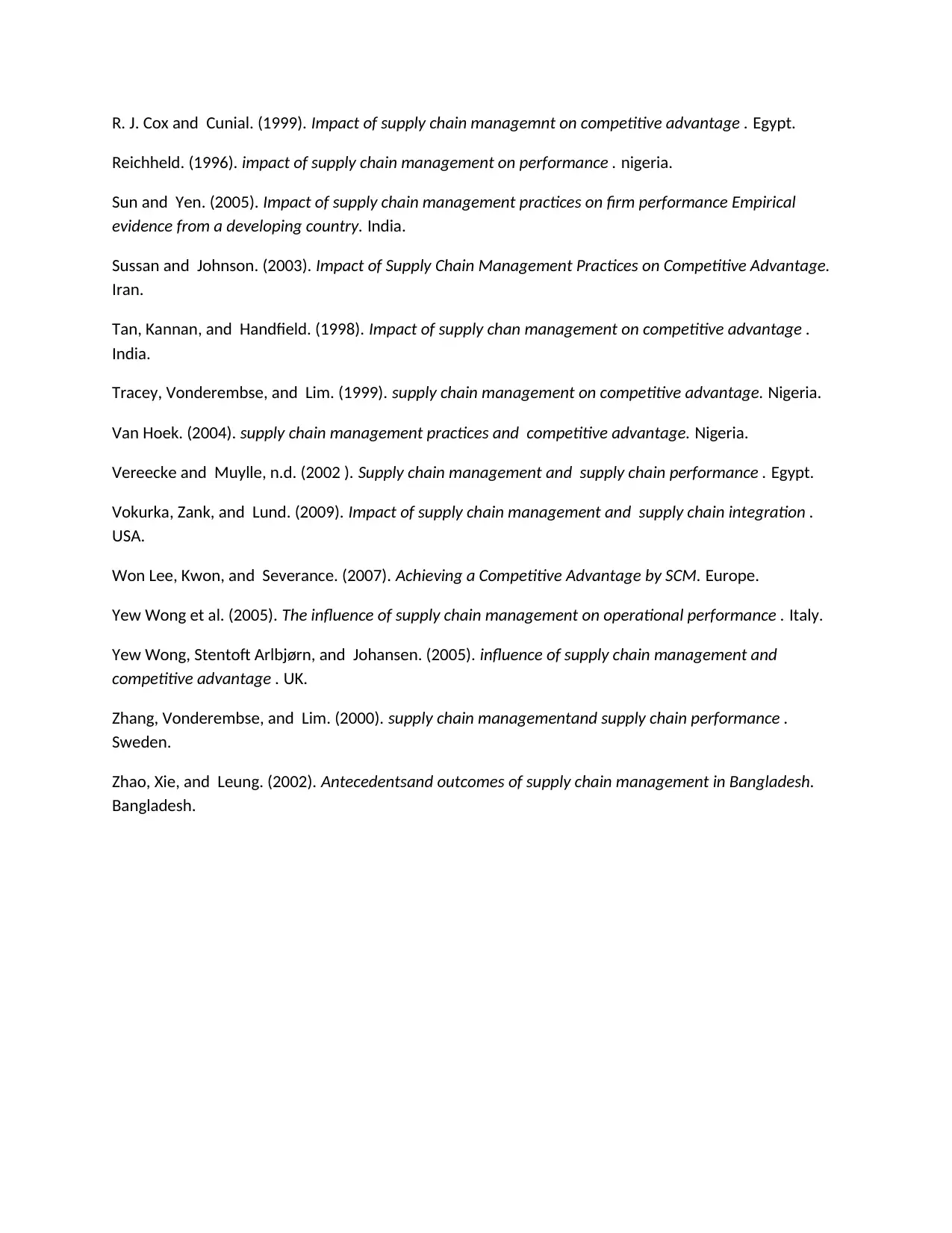
R. J. Cox and Cunial. (1999). Impact of supply chain managemnt on competitive advantage . Egypt.
Reichheld. (1996). impact of supply chain management on performance . nigeria.
Sun and Yen. (2005). Impact of supply chain management practices on firm performance Empirical
evidence from a developing country. India.
Sussan and Johnson. (2003). Impact of Supply Chain Management Practices on Competitive Advantage.
Iran.
Tan, Kannan, and Handfield. (1998). Impact of supply chan management on competitive advantage .
India.
Tracey, Vonderembse, and Lim. (1999). supply chain management on competitive advantage. Nigeria.
Van Hoek. (2004). supply chain management practices and competitive advantage. Nigeria.
Vereecke and Muylle, n.d. (2002 ). Supply chain management and supply chain performance . Egypt.
Vokurka, Zank, and Lund. (2009). Impact of supply chain management and supply chain integration .
USA.
Won Lee, Kwon, and Severance. (2007). Achieving a Competitive Advantage by SCM. Europe.
Yew Wong et al. (2005). The influence of supply chain management on operational performance . Italy.
Yew Wong, Stentoft Arlbjørn, and Johansen. (2005). influence of supply chain management and
competitive advantage . UK.
Zhang, Vonderembse, and Lim. (2000). supply chain managementand supply chain performance .
Sweden.
Zhao, Xie, and Leung. (2002). Antecedentsand outcomes of supply chain management in Bangladesh.
Bangladesh.
Reichheld. (1996). impact of supply chain management on performance . nigeria.
Sun and Yen. (2005). Impact of supply chain management practices on firm performance Empirical
evidence from a developing country. India.
Sussan and Johnson. (2003). Impact of Supply Chain Management Practices on Competitive Advantage.
Iran.
Tan, Kannan, and Handfield. (1998). Impact of supply chan management on competitive advantage .
India.
Tracey, Vonderembse, and Lim. (1999). supply chain management on competitive advantage. Nigeria.
Van Hoek. (2004). supply chain management practices and competitive advantage. Nigeria.
Vereecke and Muylle, n.d. (2002 ). Supply chain management and supply chain performance . Egypt.
Vokurka, Zank, and Lund. (2009). Impact of supply chain management and supply chain integration .
USA.
Won Lee, Kwon, and Severance. (2007). Achieving a Competitive Advantage by SCM. Europe.
Yew Wong et al. (2005). The influence of supply chain management on operational performance . Italy.
Yew Wong, Stentoft Arlbjørn, and Johansen. (2005). influence of supply chain management and
competitive advantage . UK.
Zhang, Vonderembse, and Lim. (2000). supply chain managementand supply chain performance .
Sweden.
Zhao, Xie, and Leung. (2002). Antecedentsand outcomes of supply chain management in Bangladesh.
Bangladesh.
1 out of 24
Related Documents
Your All-in-One AI-Powered Toolkit for Academic Success.
+13062052269
info@desklib.com
Available 24*7 on WhatsApp / Email
![[object Object]](/_next/static/media/star-bottom.7253800d.svg)
Unlock your academic potential
© 2024 | Zucol Services PVT LTD | All rights reserved.




